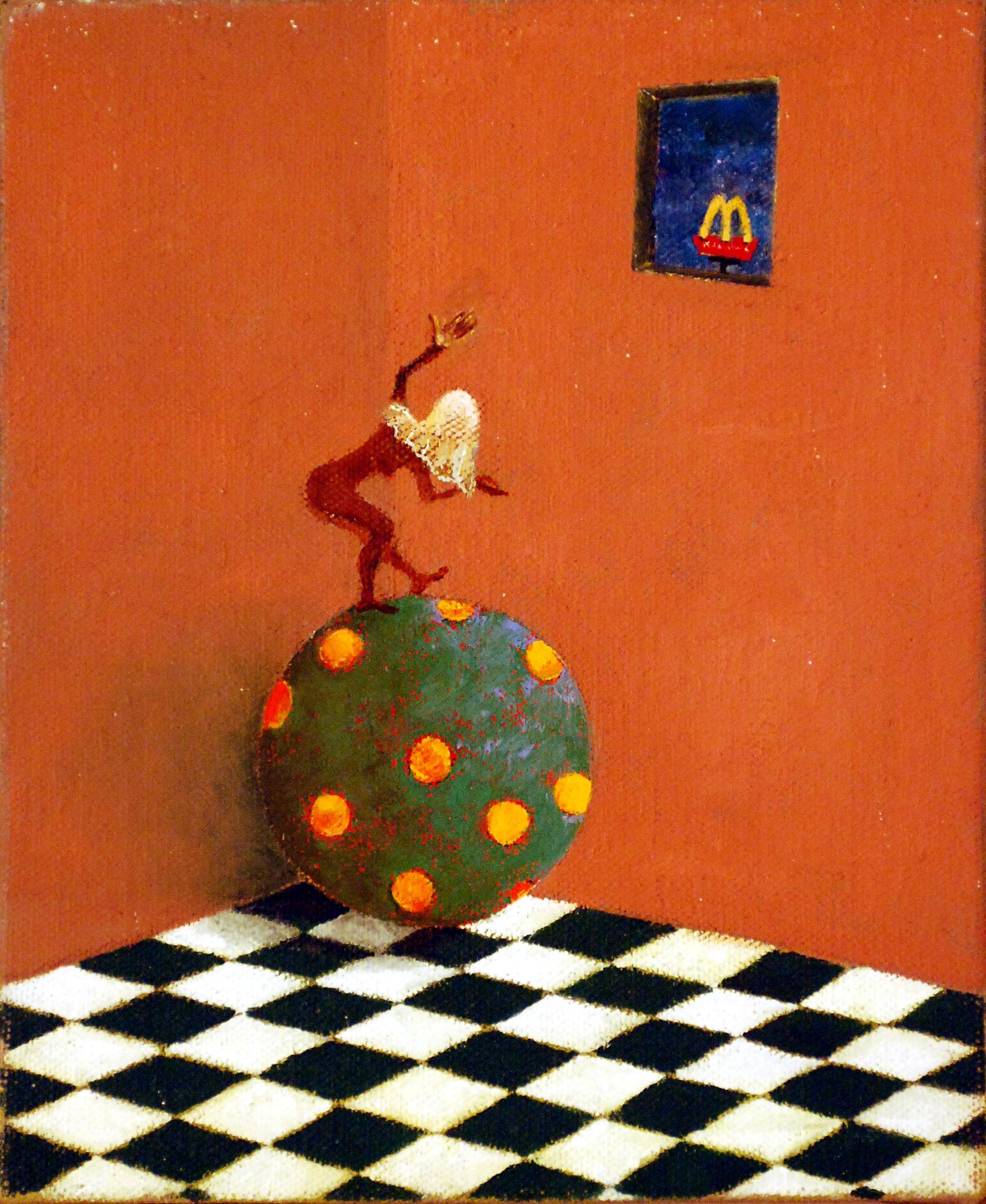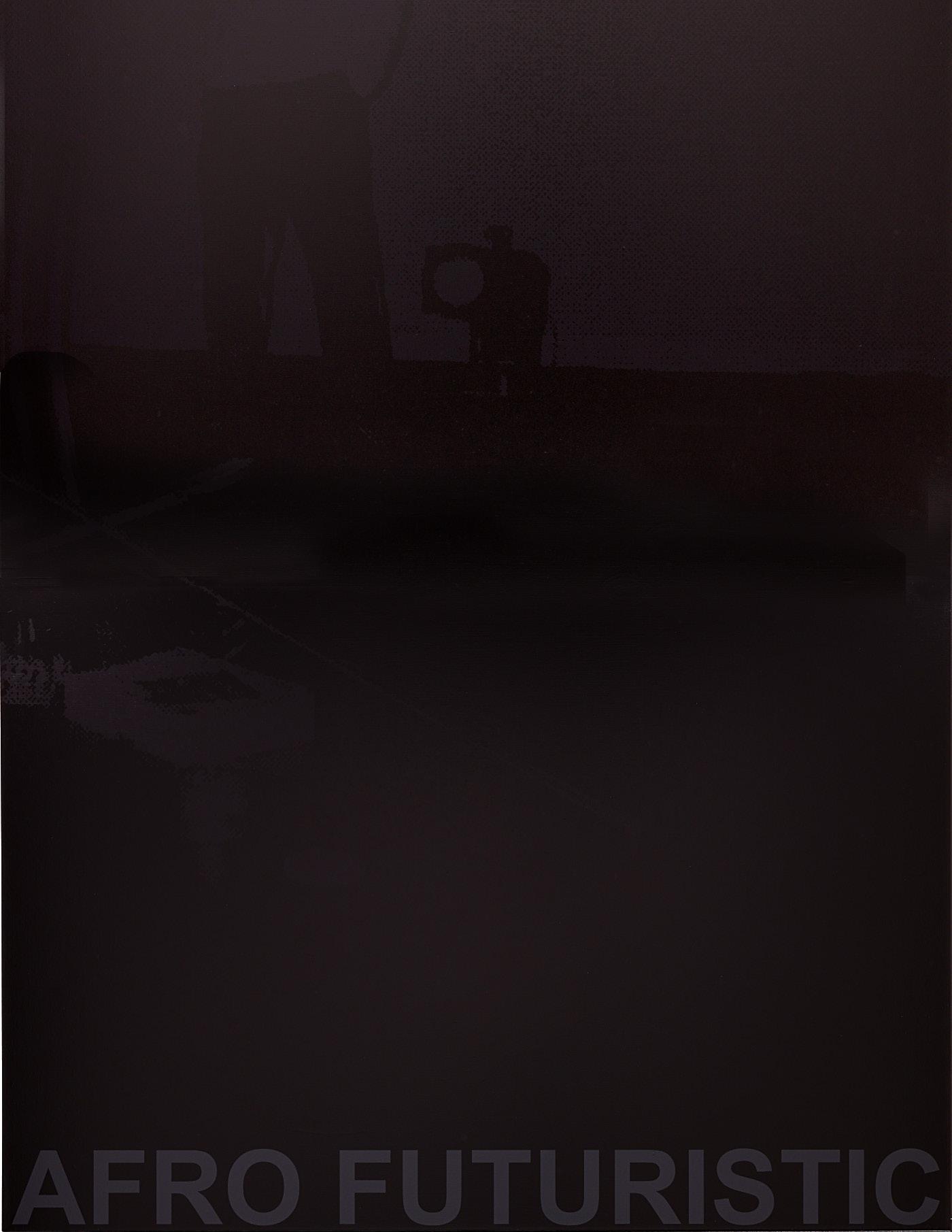


























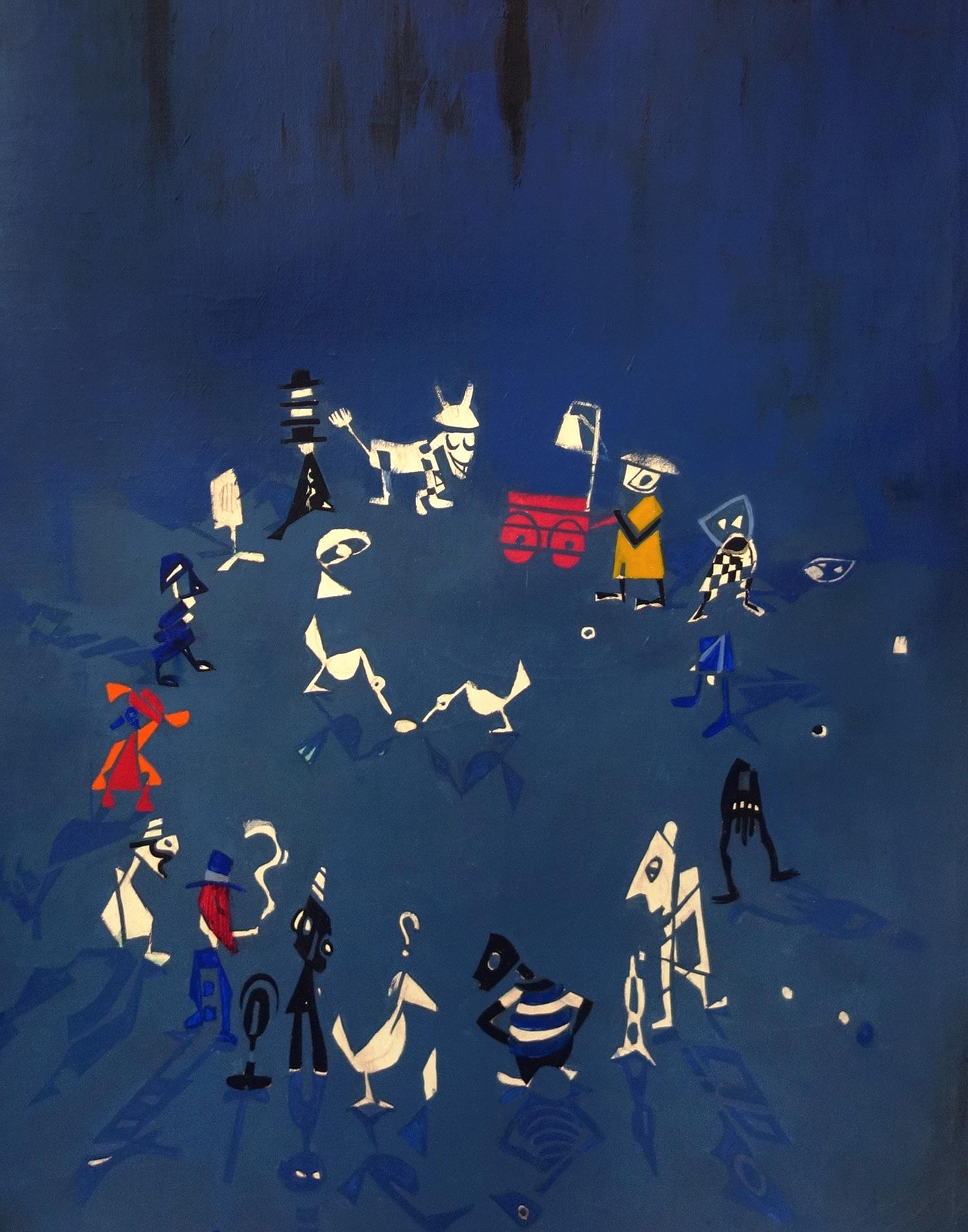 Norman Lewis Games 1965 Oil on Canvas
61 x 36 in. (156.8 x 91.4 cm)
Norman Lewis Games 1965 Oil on Canvas
61 x 36 in. (156.8 x 91.4 cm)
Bill Hodges Gallery celebrates the vibrant, varied, and resilient artistic perspectives that comprise the Black art genre with Black Aliveness: A Summer Exhibition. Curated from the gallery’s forty-year collection of historic works, this exhibition offers a fascinating glimpse of American life through the eyes of African American artists. With works such as Merton Simpson’s captivating Confrontation II-A, Willie Cole’s intricately-beaded Elegba, Kara Walker’s evocative composition buoy, and more, this exhibition brings into conversation a highly important, expressive, and dynamic cohort of Black artists. The curation of Black Aliveness is informed by the generative work of scholar, Kevin Quashie. Quashie offers a concept which he terms “aliveness” in his work, urging those who appreciate Black cultural expression to advocate for a world in which one encounters Black being just as it is – rather than only as it exists in the shadow of anti-Black violence. For Black artists throughout the decades, a spirit of aliveness animates the stakes of artistic expression. These artists have drawn from a well of historic perseverance to reflect the story of their communities; in moments both jubilant and somber. This is what constitutes the heart of the exhibition. With paintings, photographs and sculptures that range from distinctly figural to contemplative abstraction, Black Aliveness highlights the titanic contributions that Black artists have made to their genre, and celebrates the vivid nature of their legacy, just as it is.
Black Aliveness centers the thematic vibrancy that lies at the core of the Black art genre. The artists represented in this exhibition are known for drawing from the dynamics facing the Black community to produce art which reflects the world both simply as it is, and also as it someday could become. In addition to the artists previously mentioned, this exhibition also features insightful works by Romare Bearden (1911 – 1988), Willie Cole (1955 – ), Harold B. Cousins (1916 – 1992), Richard Hunt (1935 – ), Zanele Muholi (1972 – ), Adam Pendleton (1984 – ), Howardena Pindell (1943 – ), Merton Simpson (1928 – 2013), John Tarrell Scott (1940 - 2007), and Kara Walker (1969 – ).
Richard Hunt, born in 1935, grew up in the south side of Chicago, immersed in the art world through classes at the Middle School Program (MSP) at the School of the Art Institute of Chicago (SAIC). During his formative artistic years, he worked with clay and carvings. He had a makeshift studio in his bedroom until he built a studio in the basement of his father’s barbershop. After graduating with a bachelor’s degree in art education from the Art Institute of Chicago, Hunt received a fellowship grant from the Art Institute to travel around Europe and further his studies. The experience of touring England, Spain, France, and Italy solidified his interest in the medium of welded and cast steel, aluminum, copper, and bronze. Hunt has been known to experiment with metals found in junkyards and with old car parts, which he deconstructs to shape abstract, organic, forms that reference surrealist representations of nature, animals, and humans. The sculpture is monolithic and enclosed; the form is solid and dense, with airy notes offered by the changes and the curves. Working out of a sprawling trolley train station turned professional studio, Hunt has produced a body of work that distinguishes him as the most prolific site-specific artist in the world. Hunt received numerous fellowships, including the Guggenheim fellow. By 1969, he was the first African American sculptor to be honored with a retrospective exhibition at the Museum of Modern Art in New York.
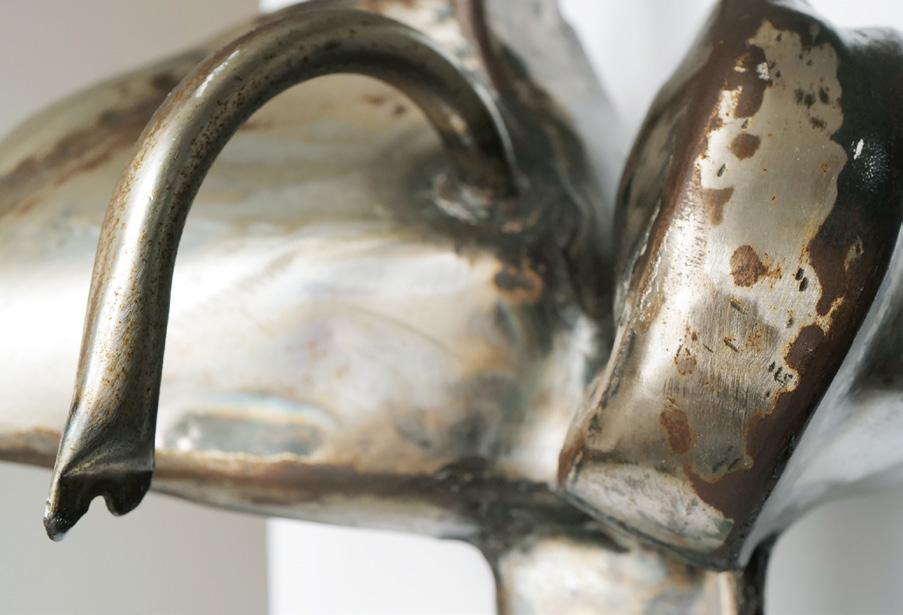
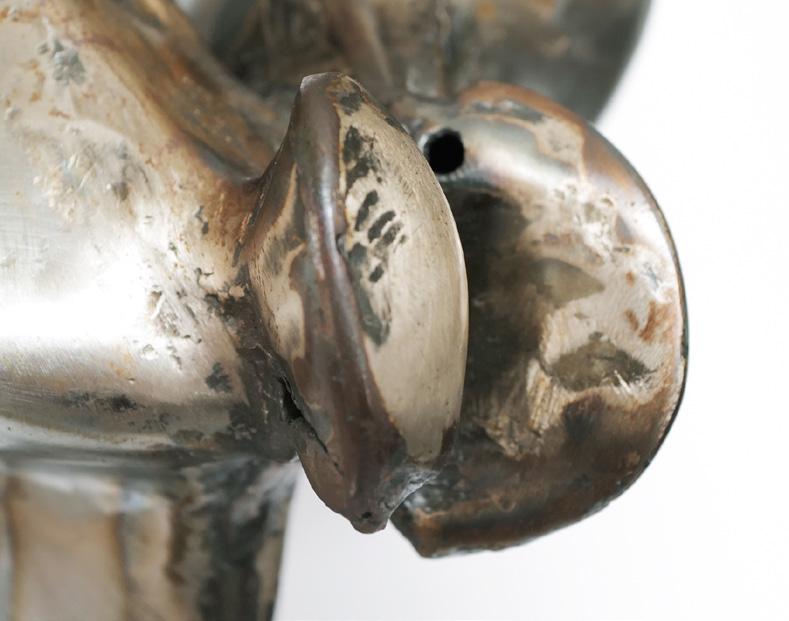
Richard Hunt's sculptures are renowned for their fine balance of delicate, outstretched scions, often welded to a dense, angular base. Many of Hunt's works contain parts derived from automobiles and assorted industrial elements; which imbue his compositions with a blend of organic and mechanical references; comprising triumphant shapes in space, finished with premier welding. Hunt's attention to fine art, material and texture is exemplified in Winged Hybrid (1973), a phenomenal work of sculptural genius assembled from automobile parts and welded into a luminous, curving silhouette. Produced fifty years ago, this museum-caliber work is a profound example of Hunt's insightful craftsmanship. From the smooth shine of light glinting off the edge of steel to the captivating gradation of color on chrome, Hunt's brilliance with regard to compositional balance with wrought metals remains unparalleled. Luminous from all angles, Winged Hybrid is a profound instance of sculptural virtuosity.
Provenance
Estate of Mason Adams
Bill Hodges Gallery, New York, NY
Literature
Bill Hodges Gallery, Masterworks of the African Diaspora, New York, 2023, illus. p. 17
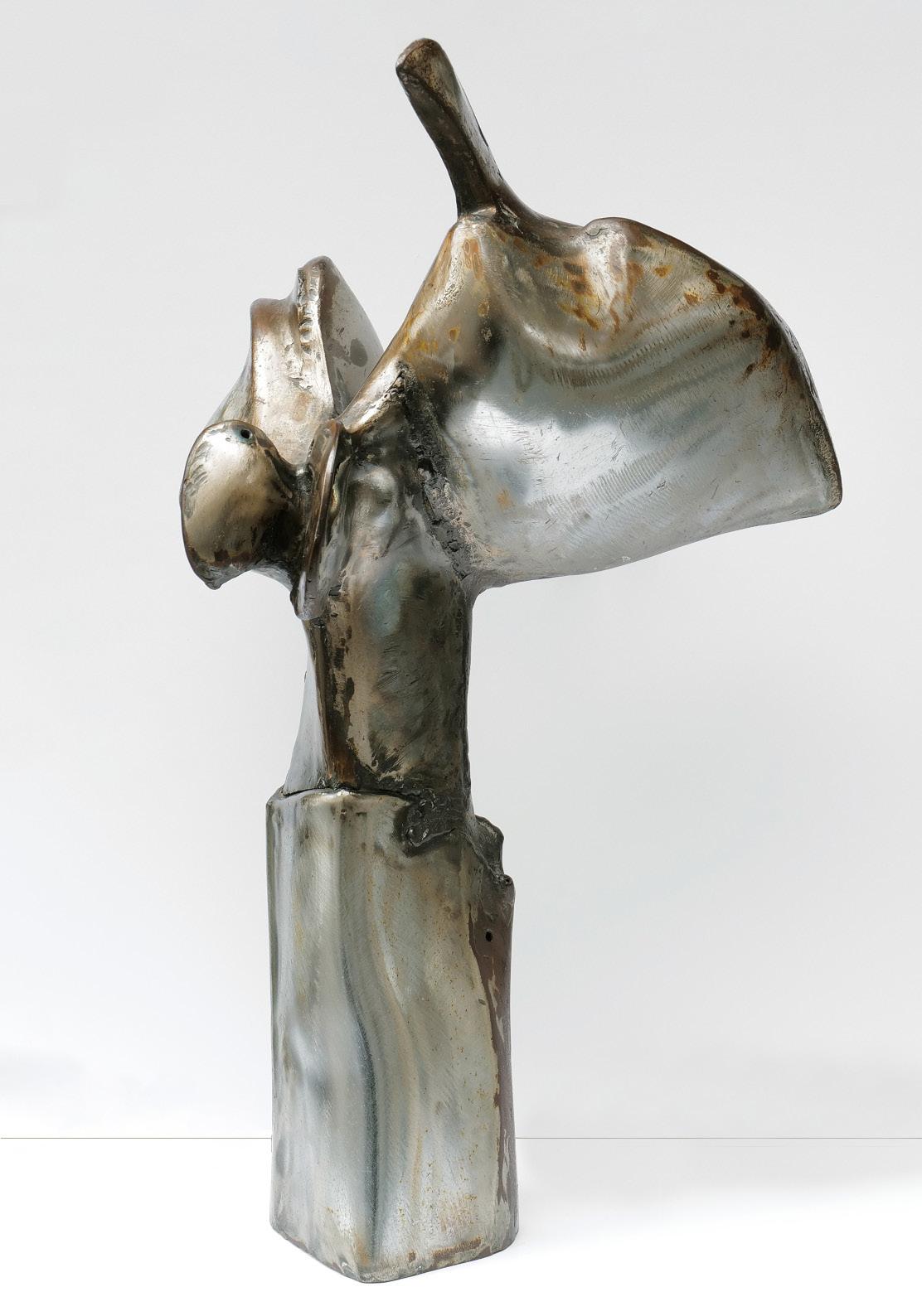
Welded Chrome
28 x 16 x 12 ½ in. (71.1 x 40.6 x 31.8 cm)
Signed and Dated: R. Hunt 73
Zanele Muholi is a South African artist and visual activist; they work in photography, video, and installation. For over a decade they have documented the lives of black lesbian, gay, bisexual, transgender, and intersex communities in various townships in South Africa. Responding to the continuing discrimination and violence faced by the LGBTI community, in 2006 Muholi embarked on an ongoing project, Faces, and Phases, in which they depict black lesbian and transgender individuals. Muholi’s self-proclaimed mission is "to re-write a black queer and trans visual history of South Africa for the world to know of our resistance and existence at the height of hate crimes in SA and beyond." In a more recent ongoing series, Somnyama Ngonyama (Hail the Dark Lioness), Muholi becomes both the participant and the image-maker, as they turn the camera on themselves. Experimenting with different characters and archetypes, Muholi’s self-portraits reference specific events in South Africa’s political history. Through exaggerating the darkness of her skin tone, Muholi reclaims their blackness and offsets the culturally dominant images of black women in the media today.
Ropes that could bind and constrict are seen instead winding gracefully around the proud neck of a black figure in Zanele Muholi’s gelatin silver print MaID, Philadelphia. n this work, Muholi turns the camera to themselves. A part of the series Somnyama Ngonyama (meaning ‘Hail, the Dark Lioness’), MaID, Philadelphia, a self-portrait, aims at the politics of race in the photographic archive. A composition wherein the subject’s unwavering resolute gaze is the focal point, Muholi portrays themselves in a highly-stylized fashion. The image maintains a softness despite the visual confrontation of the gaze; as the figure’s sable visage anchors the rhythm of the work. In MaID, Philadelphia and related works, Muholi asserts the stakes of racial representation and expression, the conventions of which they feel “[are] continuously performed by the privileged others”. With their camera, Muholi questions the current hierarchy of the art world and fills the vacancy in the related field of documentary photography.
Provenance
Estate of Mason Adams
Bill Hodges Gallery, New York, NY
Literature
Bill Hodges Gallery, Masterworks of the African Diaspora, New York, 2023, illus. p. 17

Romare Bearden's body of work stands as a pillar of Black art, depicting the lives of African Americanonnecting the people to current social unrest. At the start of his career, Bearden studied at the Art Student League of New York, a government-funded project, and illustrated political cartoons for Baltimore Afro-Americans. Bearden became acquainted with the popular themes and styles created by African American artists and realized the inadequacy of political art. Bearden intended to utilize his work to move social boundaries and expand critics' recognition of African American art beyond the limitation of "African idiom" by exhibiting the expansive topics African American artists can cover. In the 1960s, to create better social connections with his works while innovating his artistic approach, Bearden started exploring while drawing references to events he experienced and depicted in his early works. Through the gradual transition, Bearden eventually found a collage, using pieces of painted color patches and arranging them into paintings like abstractions. One step further, to draw political connections with his collages' content without depicting a political event scene, Bearden uses sources directly from newspapers and magazines. In their original content, Bearden's sources delineate black people and their experiences in specific events, so Bearden's audiences can draw recognizable connections when viewing Bearden's works. The representation of black people in popular media was always filtered through social categorization, which parallels Bearden's concern about the understanding of black artists by critics and the art world. To challenge the limitation, Bearden constantly deconstructs his sources into fragments in organic shapes and rearranges them randomly, so the context of the original narrative is also deconstructed.
Over the decades, Bearden has been the focus of several museum retrospectives including those organized by the Museum of Modern Art, Mint Museum of Art, Detroit Institute of the Arts, Studio Museum in Harlem, and National Gallery of Art. His work is collected by the Metropolitan Museum of Art, Museum of Modern Art, Whitney Museum of American Art, National Gallery of Art, Philadelphia Museum of Art, Museum of Fine Arts, Boston, and the Studio Museum in Harlem. In 1984, he received the Mayor's Award of Honor for Art and Culture in New York City, and in 1987, he was awarded the President's National Medal of the Arts. In March of 1988, Bearden passed away in New York City. Two years after his death, the Romare Bearden Foundation was established, working to preserve the legacy and memory of his foundational body of work.
Sunset, a collage of verdant greens, delicately accented by the magenta hues of a figure cradled in foliage abound. Though shape and shadow are bisected and sourced from the saturated dyes of cuttings and photographs, the composition of Sunset is imbued with a dreamy gentleness that an impressionist scene of idyllic nature might invoke. The feminine figure in the foreground, whose shades of orange share a color palette only with the setting sun, is the portrait of interior serenity. Donning a beaded headband with eyes not quite closed, the corners of her mouth curve into a gentle smile. Bearden, a tour de force of the mixed media and collage genre, beckons viewers to consider how a spirit of tranquility can be inscribed within pressed layers of paper on fiberboard. Created at the height of the artist’s collage works, Bearden’s Sunset is the pinnacle of craft and detail, illustrative of an artist’s keen sensibility of surreal place and personhood that a work can evoke.
Provenance
Private Collection, New York, NY
Bill Hodges Gallery, New York, NY
Exhibition History
Romare Bearden: Narrations, 22 September – 29 December 2002, Neuberger Museum of Art, Purchase College, State University of New York, Purchase, NY
Romare Bearden: Narrations, 7 February – 23 April 2003, Flint Institute of Arts, Flint, MI
Romare Bearden: Narrations, 22 May – 20 July 2003, Delaware Art Museum (First USA Riverfront Art Center), Wilmington, DE
Bearden & Company, 27 February – 28 August 2020, Bill Hodges Gallery, New York, NY
Selections from the Hamptons Virtual Art Fair, 3 September – 17 October 2020, Bill Hodges Gallery, New York, NY
Selections from the Collection, 15 April – 29 May 2021, Bill Hodges Gallery, New York, NY
Figuratively Speaking, 2 March – 6 May 2023, Bill Hodges Gallery, New York, NY
Masterworks of the African Diaspora, 13 July – 16 July 2023, Hamptons Fine Art Fair, Southamptons, NY
Literature
Bill Hodges Gallery, Masterworks of the African Diaspora, New York, 2023, illus. p. 13
Sunset, 1980-81
(Also Known As Mysterious Woman in Swamp)
Collage and Mixed Media on Fiberboard
14 x 18 in. (35.6 x 45.7 cm)
Signed, Titled, Dated and Inscribed on Reverse: "Sunset” Collage & Mixed Media 1980/1981, Romare Bearden
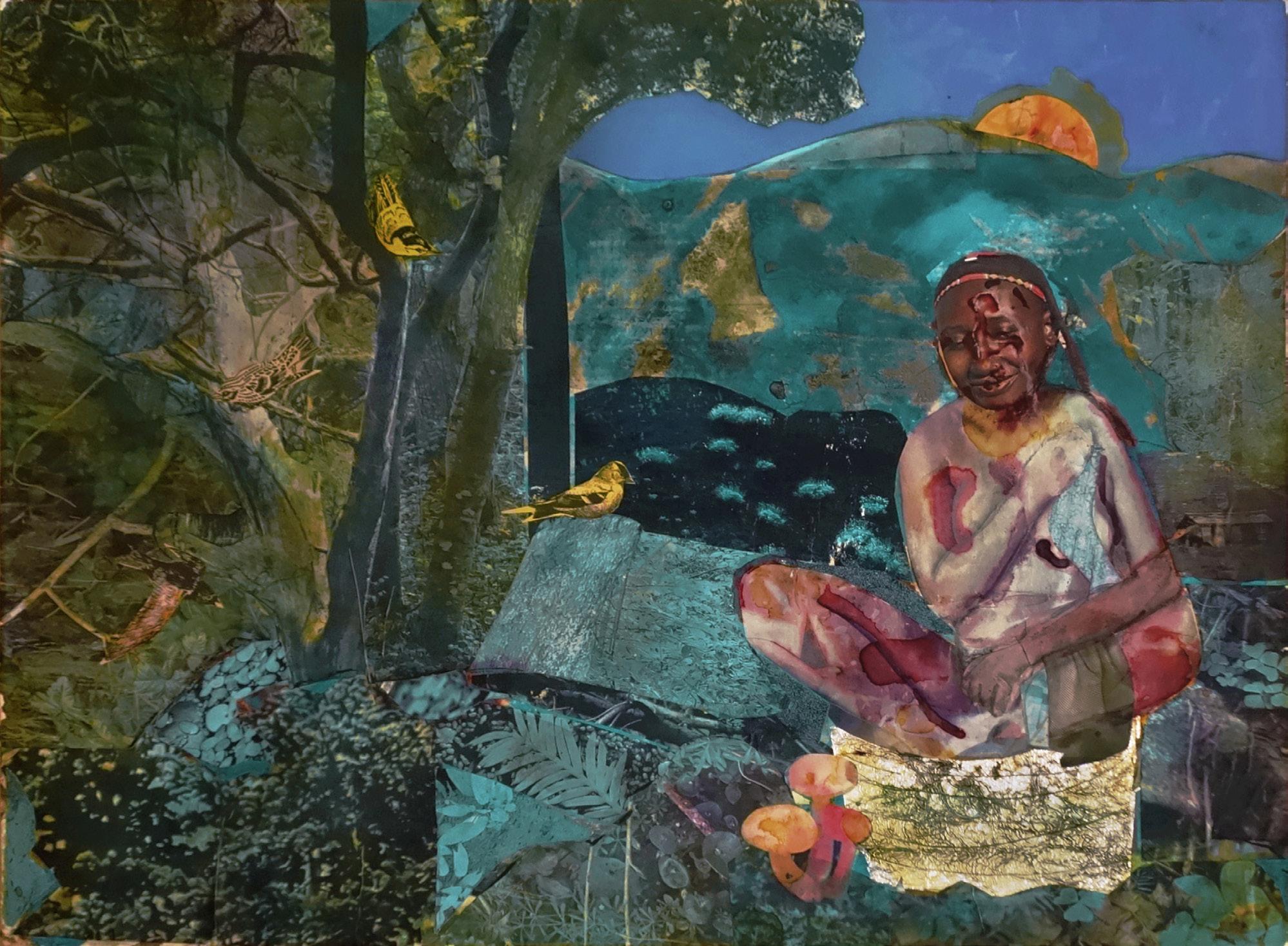
Zanele Muholi is a South African artist and visual activist; she works in photography, video, and installation. For over a decade she has documented the lives of black lesbian, gay, bisexual, transgender, and intersex in various townships in South Africa. Responding to the continuing discrimination and violence faced by the LGBTI community, in 2006 Muholi embarked on an ongoing project, Faces, and Phases, in which they depict black lesbian and transgender individuals. Muholi’s self-proclaimed mission is "to re-write a black queer and trans visual history of South Africa for the world to know of our resistance and existence at the height of hate crimes in SA and beyond." In a more recent ongoing series, Somnyama Ngonyama (Hail the Dark Lioness), Muholi becomes both the participant and the image-maker, as they turn the camera on themselves. Experimenting with different characters and archetypes, Muholi’s self-portraits reference specific events in South Africa’s political history. Through exaggerating the darkness of her skin tone, Muholi reclaims their blackness and offsets the culturally dominant images of black women in the media today.
They look directly into you with their beautifully almond-shaped eyes and interact with you. They seem to have something to say to you, but they remained silent. Silence is a source of great strength. Hollow pattern bag - the symbol of the hand-woven technique combined with the leather material, flows along their shoulder. The photograph brings a peaceful acceptance of the past. Yet their body is leaning slightly forward to the camera, to the viewer, suggesting the possibility of movement, a gesture that heralds changes. In Cebo, Philadelphia, Muholi turns the camera on themselves, showing their fiery self, suppressed roar, and the power gushing out, in silence but vividly alive. You look into their soul and see and feel the firm belief in themselves and their cause.
Cebo, Philadelphia, 2018
Gelatin Silver Print Edition of 5 30 x 23 ¾ in. (76.2 x 60.3 cm)

Kara Walker is an American contemporary painter, print-maker, installation artist, filmmaker, and professor who explores race, gender, sexuality, violence, and identity in her work. Walker was born in Stockton, California in November of 1969. From a young age, she was often surrounded by art, as her father Larry Walker was a painter. Her proximity to the narrative ability that artwork holds inspired her to pursue the arts. Moving with her family from California to Georgia, Walker spent a significant portion of her childhood in Atlanta, going on to attend the Atlanta College of Art in 1991, where she earned her Bachelor of Arts degree in painting and printmaking in 1991. Walker then attended the Rhode Island School of Design, where she earned a Master of Fine Arts degree in painting and printmaking in 1994. While attending RISD, Walker experimented with her signature black and white paper cutouts of silhouetted human forms. These forms depicted not only forms but scenes of race relations in the Antebellum South.
In 1997, at the age of 27, Walker became one of the youngest awardees of the John D. and Catherine T. MacArthur Foundation Genius Grant. In addition to receiving the grant, she went on the serve as the United States Representative in the 2002 São Paulo Biennial. In 2006, the Metropolitan Museum of Art featured her works in the exhibition After The Deluge, where her evocative works stood in aesthetic juxtaposition with historic objects from the Museum’s collection “in order to explore the banality of everyday life, water, and its impact.” Walker has since been the focus of many major exhibitions around the world. One of her most widely discussed exhibitions, A Subtlety, debuted in 2014 at the Domino Sugar Factory in Brooklyn, New York. Titanic in size and stature, the installation centered around a sugar-coated depiction of a nude, buxom African figure, rising in a sphinx pose. From prints to sculpture, Walker’s oeuvre offers a powerful, unflinching critique of American imperialism, as incisive as it is interrogative, as brilliant as it is essential to the canon of contemporary art.
Buoy is one work from a series of six prints titled An Unpeopled Land in Uncharted Waters by Kara Walker depicts various scenes concerning the devastating transatlantic slave trade using Walker’s familiar style of dramatic monochrome and exaggerated features. buoy, is a curious piece as it is more fantastical than contextual compared to the other works in the series. Pictured here, created from aquatint, is the floating body of a Black man camouflaged in a pool of more black. The character’s eyes sink lifelessly towards the water as his head and body float. On the character’s stomach lies a ghastly woman with petrified eyes and flowing hair. Roped around her neck and bare abdomen are two, small black arms pulling her down into the darkness surrounding her and lifeless character. This somber portrait presents difficult ideas and histories in such bare, analogical terms, which is a strong suit of Walker’s style.
buoy, 2010
Etchiung with Aquatint, Sugar-lift, Spit-bite and Dry-point, Painted on Hahnemuhle Copperplate Bright White 300gm paper, Edition of 30
Image: 23 ¾ x 32 1/4 in. (60.3 x 81.9 cm)

Paper: 30 1/4 x 36 1/4 in. (76.8 x 92.1 cm)
Signed and Dated, Lower Right: KW 2010
In 1967, Richard Hunt received a commission for his first public sculpture, Play, and in 1971, he was the first African American sculptor to have a solo exhibition at the Museum of Modern Art (MoMA) in New York. Hunt established his studio center in Benton Harbor, Michigan in 2006, where artists of all disciplines could work, attend workshops, learn, and teach in the community. Today, Hunt has over 125 commissioned public sculptures in the United States, many of which are in his hometown of Chicago, Illinois. Hunt’s work can be seen at numerous museums, including The National Gallery of Art, Washington, D.C.; the Whitney Museum of American Art, New York; the Metropolitan Museum of Art, New York; the Art Institute of Chicago, Illinois; and the National Museum of American Art in Washington, D.C.
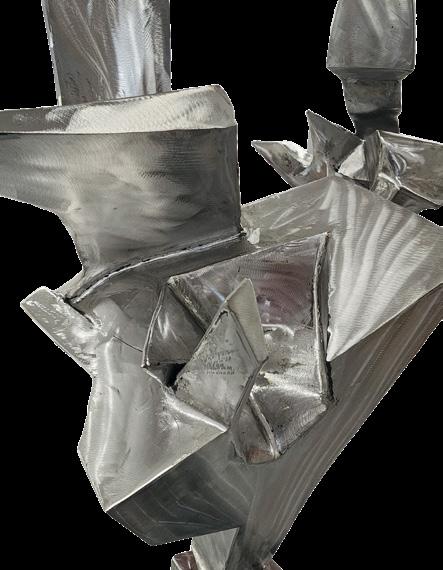
Title Unknown, 2022, recent work by internationally celebrated African American sculptor Richard Hunt continues Hunt's artistic exploration from the early 1970s. Hunt’s numerous public commissions working with sculptures in large sizes showcase his significance as a public figure and his eminent role in the African American community. With a strong interest in metal sculptures, Hunt became his adventure in both the creative language and technical possibilities. Observing organic and machine structures' formation and spatial content, he combined his modern urban life with African American experiences, deconstructed a coherent narrative within one single object, rearranged pieces and symbols from various sources, and reconstructed them into new construction. Through Hunt’s sculpture, one is able to revisit his personal experiences. Hunt wanted to treat his materials in increasingly broad terms; therefore, his sculptures began to increase in size after success in the technical development of compounding parts into a single formation. He challenges his previous techniques in each of his larger pieces, utilizing advanced ways. As seen today, from the example of Title Unknown, his sculptures evolved around architectural style. Through its size and volume, different emotions and sensibilities are conveyed and offered to the audiences.
Provenance
The Artist
Bill Hodges Gallery, New York, NY
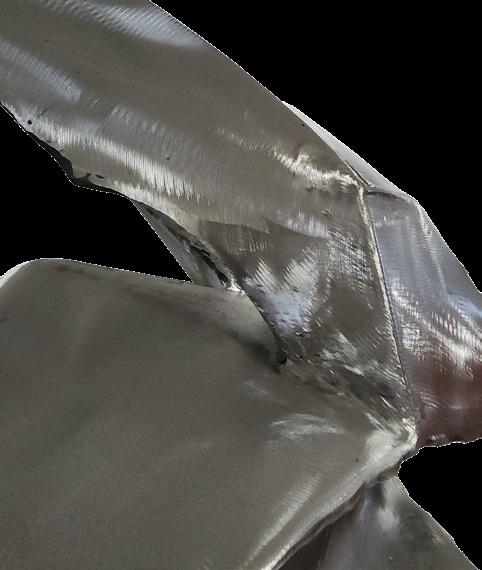
Exhibition History
Masterworks of the African Diaspora, 13 July – 16 July 2023, Hamptons Fine Art Fair, Southamptons, NY
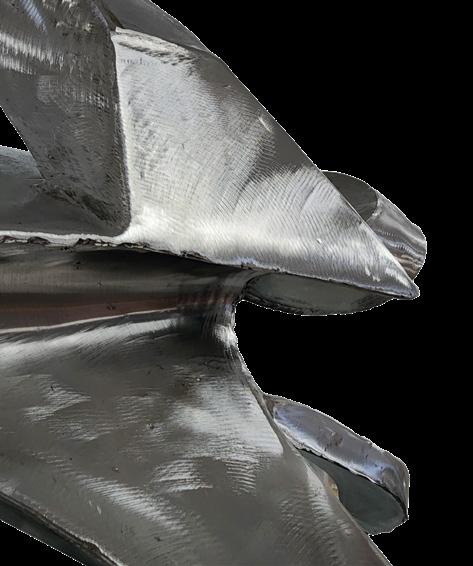
Literature
Bill Hodges Gallery, Masterworks of the African Diaspora, New York, 2023, illus. p. 21
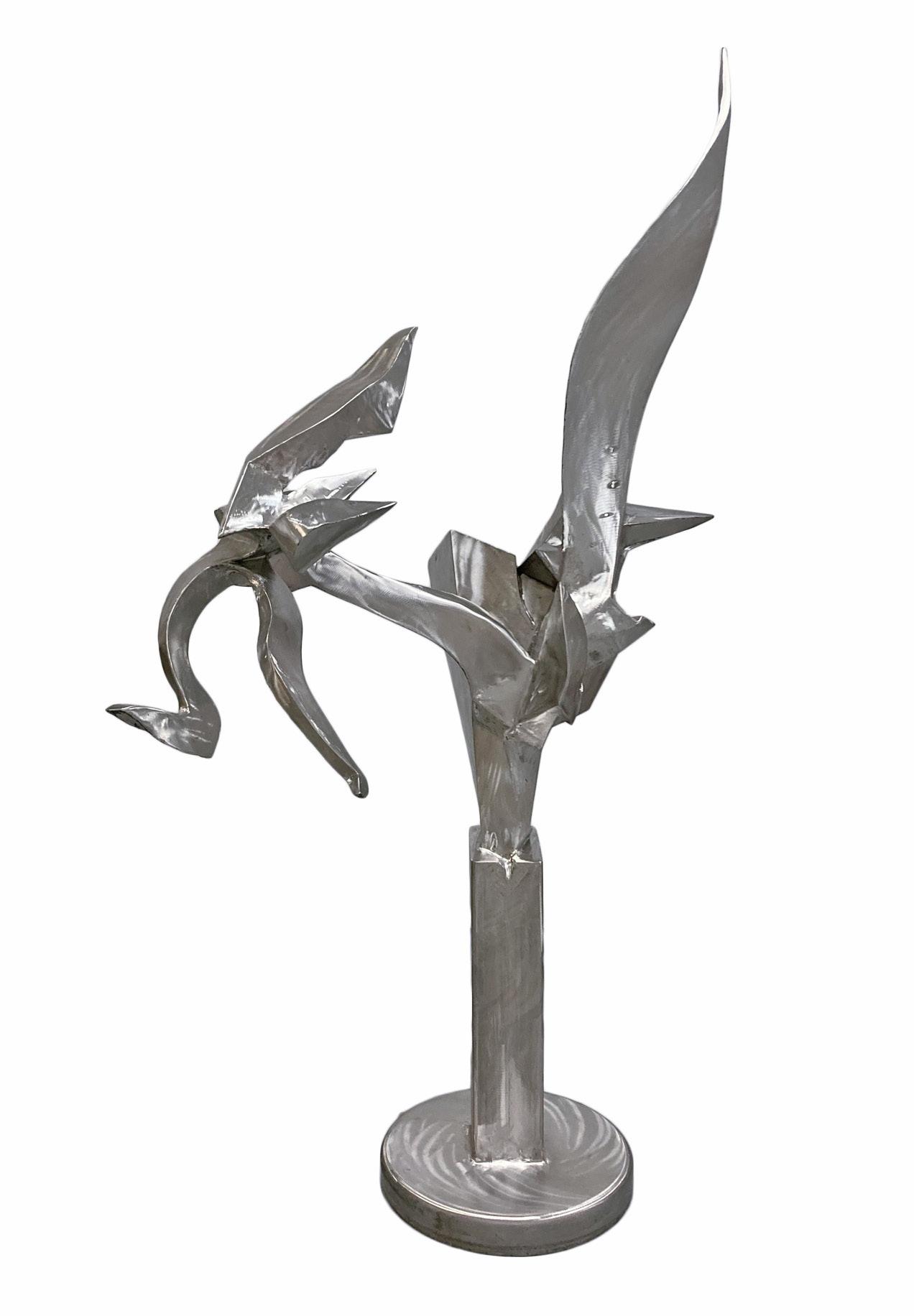
John Tarrell Scott is an American Artist best known for his large-scale woodcut prints and colorful kinetic sculptures that draw upon African American traditions and themes. Scott was born on June 30, 1940, in New Orleans, Louisiana. He graduated from Xavier University of Louisiana with a Bachelor of Art degree in Fine Arts; and later received his MFA in sculpture and printmaking from Michigan State University, in 1965. Since then, he has been an instructor at Xavier for 40 years, where he taught painting, drawing, printmaking, sculpting, paper-making, bronze casting, and calligraphy. In 1992, he was awarded a MacArthur Fellowship Grant, which he applied towards building a larger studio. After gaining attention among artists and collectors, Scott received honorary degrees from multiple universities, including Loyola University of Louisiana, Tulane University in New Orleans, Madonna College of Michigan, and Xavier University of Louisiana. Scott was the subject of a major retrospective exhibition at the New Orleans Museum of Art in 2005 titled Circle Dance: The Art of John T. Scott. Over the years, Scott was also commissioned to create and install several public works throughout the city of New Orleans, including Spirit Gates at the DeSaix Boulevard traffic circle in the Seventh Ward and River Spirit at Woldenberg Park along the Mississippi River.
Scott’s work is shown and collected by several institutions, notably: the Smithsonian American Art Museum, Washington D.C.; the Museum of Fine Arts in Houston, Texas; the Ogden Museum of Southern Art in New Orleans, Louisiana; and the Fine Art Society, London.
Duet: Past and Future, this delicate and colorful kinetic sculpture is a strong example of Scott’s painted kinetic metal works. Its seemingly simple, yet complex, slender forms are inspired by the “diddley bow”, a string instrument from West African culture,1 and balanced by physics. These kinetic sculptures served as the basis for his large-scale public commissions, including “Spirit Gates” at the New Orleans Museum of Art and “River Spirit” at Woldenberg Park in New Orleans.¹
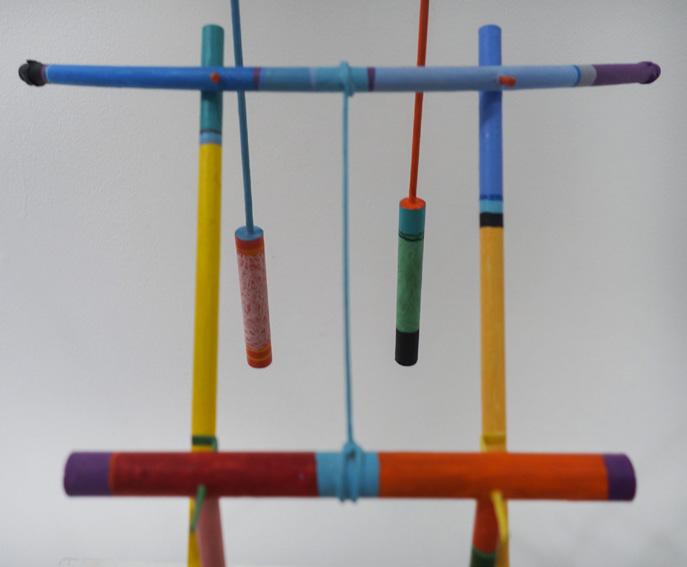
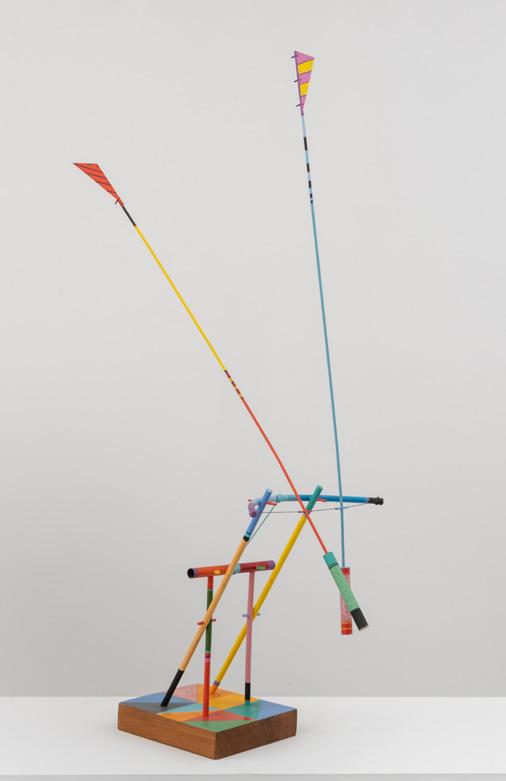
Provenance
The Artist
Bill Hodges Gallery, New York, NY
Literature
Bill Hodges Gallery, Masterworks of the African Diaspora, New York, 2023, illus. p. 21
Signed and Dated: John T. Scott 1985
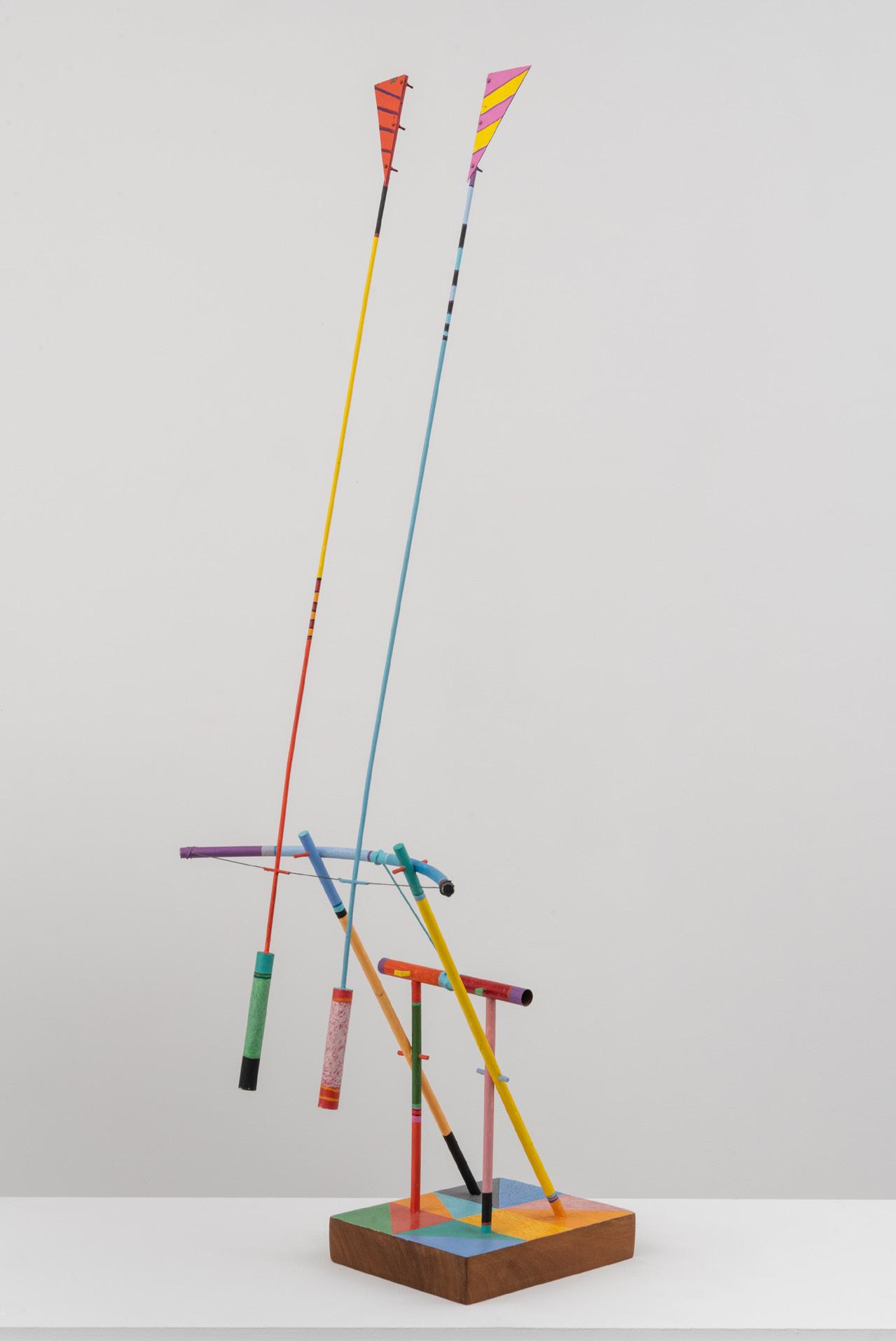
In 1949, Merton Simpson became the first African American to receive the prestigious five-year fellowship from Charleston’s Cultural Education fund; which enabled him to move to New York City after he graduated from high school. After establishing himself as an artist and gallerist, Simpson became a member of the major art collective, Spiral Group, founded by fellow artists and colleagues Norman Lewis, Romare Bearden, Al Hollingsworth, and Hale Woodruff. He also had a strong interest in African art, collecting and dealing modern artists alongside traditional works; eventually becoming one of the most prominent dealers of African art of his time. From music to painting, supporting creative expression was a core mission for Simpson, and his legacy as a philanthropist, collector, artist, and pillar of Black cultural production remains to this day.
Simpson’s Confrontation II-A is a striking and nuanced example of the artist’s meditation on race relations in the late 1960s – emerging from the artist’s Confrontation series. Simpson’s Confrontation series can be characterized by paintings that feature silhouettes and gestures of black and white faces inter-meshed and gridlocked in a charged encounter. In Confrontation II-A, the profile of two menacing, abstracted faces clash and merge into one, framed in sable shadow. Like two sides of one coin, the contours of each face find counterparts in the other, from the grimacing downturned mouths to the beseeching glints in the figures’ eyes – forming a singular visage, mired in internal conflict. Dubbed, “Mr. Mean” by Bill Hodges, this striking, large-scale work holds a special place in the heart of our gallery. Bill recounts first coming across the work in the early 1980’s, at Simpson’s annual birthday party housed in the artist’s Madison Avenue gallery. Ultimately, Confrontation II-A found a welcome home at Bill Hodges Gallery after being showcased in a 2005 solo exhibition of the artist’s work. Over the years, this work’s place in the gallery’s collection has grown to represent not only the artistic genius and historic significance of Simpson’s career, but the genuine rapport and mutual respect that Simpson and Hodges shared.
Provenance
The Artist
Philadelphia Photo Arts Center, Philadelphia, PA Bill Hodges Gallery, NY
Exhibition History
Printed Paper, 18 May – 8 July 2023, Bill Hodges Gallery, New York, NY
Literature
Bill Hodges Gallery, Masterworks of the African Diaspora, New York, 2023, illus. p. 50
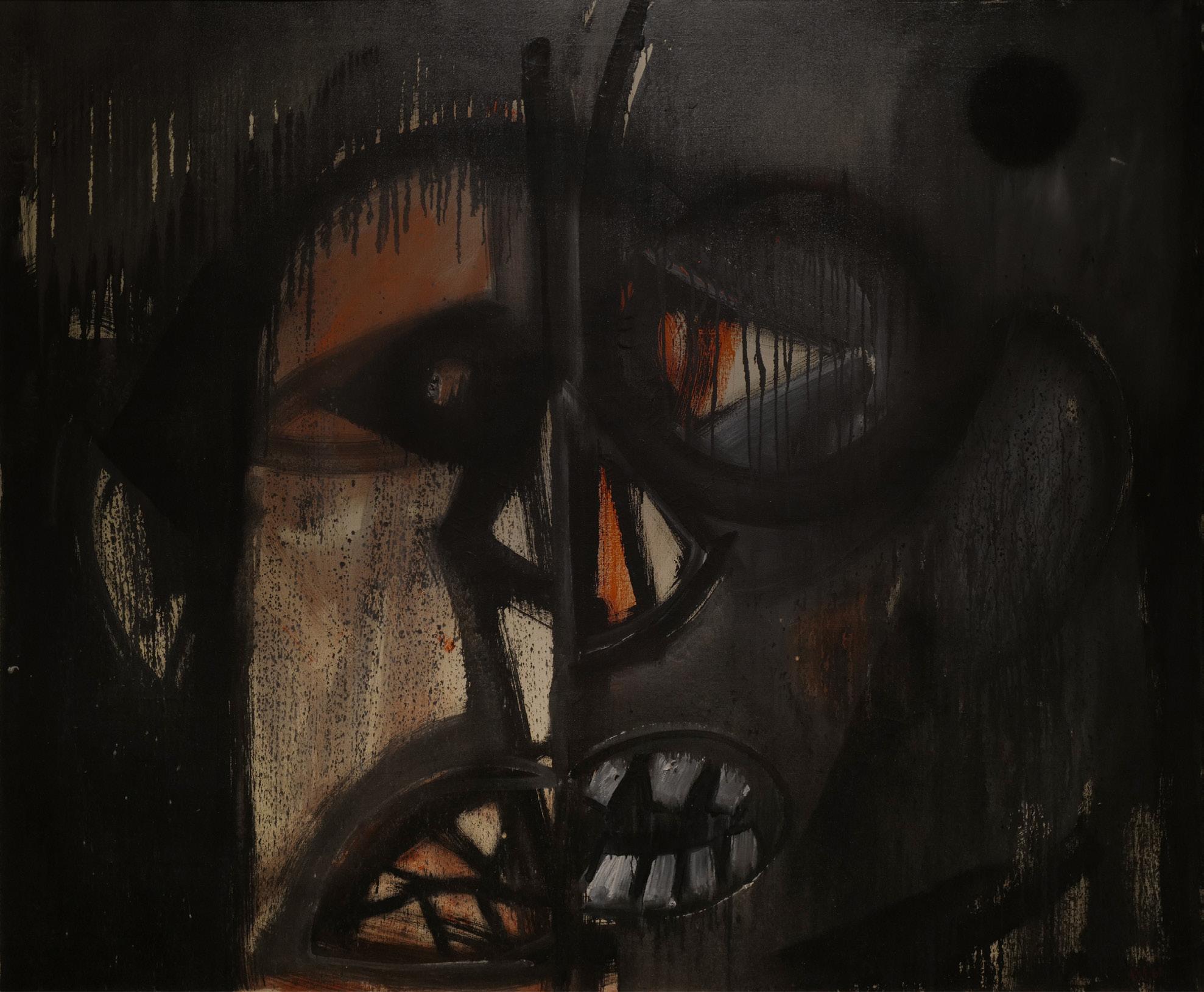
Born to Bermudian parents in Harlem, New York in 1909, Norman Lewis was interested in the arts from a young age, studying drawing and commercial design in high school. In Harlem, Lewis was surrounded by opportunities for artistic inspiration. Lewis recounted one such instance in an interview: in his early years as an artist, he spent time observing Augusta Savage in his studio and watching him create art, which offered him tremendous support in confirming his passion for art without receiving any lessons on physical techniques. Lewis went on to study at the Teacher’s College at Columbia University from 1933 to 1935. While in school, Lewis continued to engage socially by joining the 306 Group. Through both education and social events, Lewis met many artists, writers, collectors, and social activists in both Harlem and downtown. Cofounded by Charles Alston, the 306 Group is a community institution for exchanging ideas between social activists and artists. Workers from the Works Progress Administration (WPA) art project were introduced to the 306 groups to exchange ideas on the issues and struggles of black artists, pushing the progress of black people’s involvement in the WPA. With the help of his contemporaries at 306 Group, Lewis became a founding member of the Harlem Artists’ Guild in 1935. A year later he became a teacher at the Harlem Community Arts Center through the WPA. While teaching in the 1930’s Lewis’ style was a social realist marked with influences of Cubism, African sculpture, jazz, and New Negro as coined by Alain Locke.
Painted through the careful rendition of a single color, Awakening, 1969 by Norman Lewis, displays his abstract approach and the depiction of dramatic occurrences. It was painted with varying intensities of orange. The orange in the picture gives off an inviting atmosphere at first glance. White paint is applied in layers at the painting’s center, expanding horizontally on top of one another, resembling ocean waves. The brighter oranges, when viewed more extensively over the full painting’s surface, create various geometric forms that are frequently seen in other Lewis’s paintings, signifying human bodies depicting actions and motions.
Provenance
The Artist
The Artist’s Wife, Ouida B. Lewis, New York, NY Bill Hodges Gallery, New York, NY
Exhibition History
Procession: The Art of Norman Lewis, 13 November 2015 – 3 April 2016, Pennsylvania Academy of Fine Arts, Philadelphia, PA
Procession: The Art of Norman Lewis, 4 June – 21 August 2016, Amon Carter Museum of American Art, Fort Worth, TX
Procession: The Art of Norman Lewis, 17 September 2016 – 8 January 2017, Chicago Cultural Center, Exhibit Hall, Chicago, IL
Selections from the Hamptons Virtual Art Fair, 3 September – 17 October 2020, Bill Hodges Gallery, New York, NY
Norman Lewis: Shades of Blackness, 18 November 2021 – 29 January 2022, Bill Hodges Gallery, New York, NY
On the Wall, 22 September – 15 October 2022, Bill Hodges Gallery, New York, NY
BLOCKBUSTER, 27 October – 14 January 2023, Bill Hodges Gallery, New York, NY
Literature
The Studio Museum In Harlem, Norman Lewis: Black Pantings 1946-1977, New York, 1998, Plate 22, illus. p. 84
Bill Hodges Gallery, 25 Highly Important Paintings by Norman Lewis, New York, 1998, illus. p. 50
Bill Hodges Gallery, Norman Lewis: A Painter's Odyssey 1935 - 1979, New York, 2009, illus. p. 19
Ruth Fine et al., Procession: The Art of Norman Lewis, Univ. of California Press, 2015, Plate 49, illus. p. 96
Bill Hodges Gallery, Norman W. Lewis, et al., New York, 2017, illus. p. 7
Bill Hodges Gallery, Norman Lewis: Shades of Blackness, New York, 2021, illus. p. 11
Bill Hodges Gallery, Masterworks of the African Diaspora, New York, 2023, illus. p. 9
Awakening, 1969
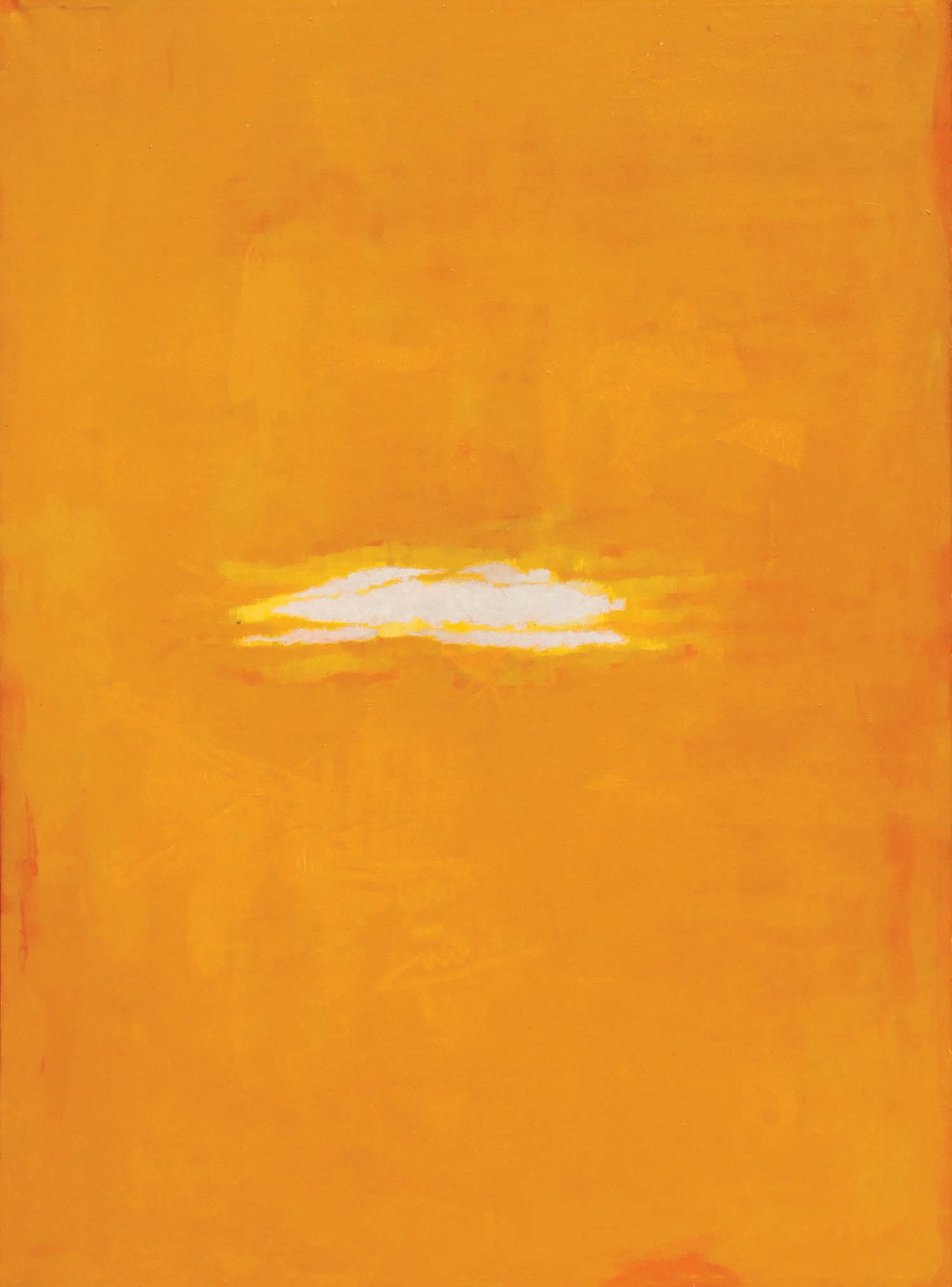
Oil on Canvas
72 x 88 ½ in. (182.9 x 224.8 cm)
Signed and Dated, Lower Right: Norman Lewis 72
Titled and Dated on Reverse: 72 – Title “Exodus"
Norman Lewis remained committed to community uplift throughout his career. In 1963, Lewis co-founded the Spiral Group with Romare Bearden, Alston, and Hale Woodruff. Lewis' support of Black artists and the Civil Rights Movement continued as he produced his signature paintings and drawings. In 1969, he also opened the Cinque Gallery with Bearden and Ernest Crichlow to support young artists and curators and provide them with a platform to practice. From 1972 until his passing in 1979, Lewis continued to mentor young artists, teaching at the Art Students League of New York. Norman Lewis passed away in 1979; his work continues to be celebrated and remembered for its lively, dynamic, and facile handling of space, color, and history.
Title Unknown, 1955–1979, is an eye-catching work of abstraction by Lewis; showing dynamic interaction between alternating blue and red hues against a grained gray background. The dark lines outlining the edges of the color blocks trace the shape of Lewis' signature active figural compositions; a style found in many of Lewis’s works, including one of his most prominent canvases, Procession 1965. Lewis' processional compositions are a mainstay of the artist's oevre, constituting a profound example of Lewis' protest paintings. While the wider range of colors dominates the lower half of the canvas, the diminishing figures behind them gently merge with the pale atmosphere as if their existence is fading in society. Completed over the course of his storied career, this work showcases Lewis’ ability for storytelling, and his penchant for creating a powerful artistic language that speaks through a timeless sphere.
Provenance Private Collection
Bill Hodges Gallery, New York, NY
Exhibition History
Selections from the Hamptons Virtual Art Fair, 3 September – 17 October 2020
Bill Hodges Gallery, New York, NY
Masterworks of the African Diaspora, 13 July – 16 July 2023, Hamptons Fine Art Fair, Southamptons, NY
Literature
Bill Hodges Gallery, Norman Lewis: A Painter's Odyssey 1935 - 1979, New York, 2009, illus. p. 27
Bill Hodges Gallery, Norman W. Lewis, et al., New York, 2017, illus. p. 25
Bill Hodges Gallery, Masterworks of the African Diaspora, New York, 2023, illus. p. 25
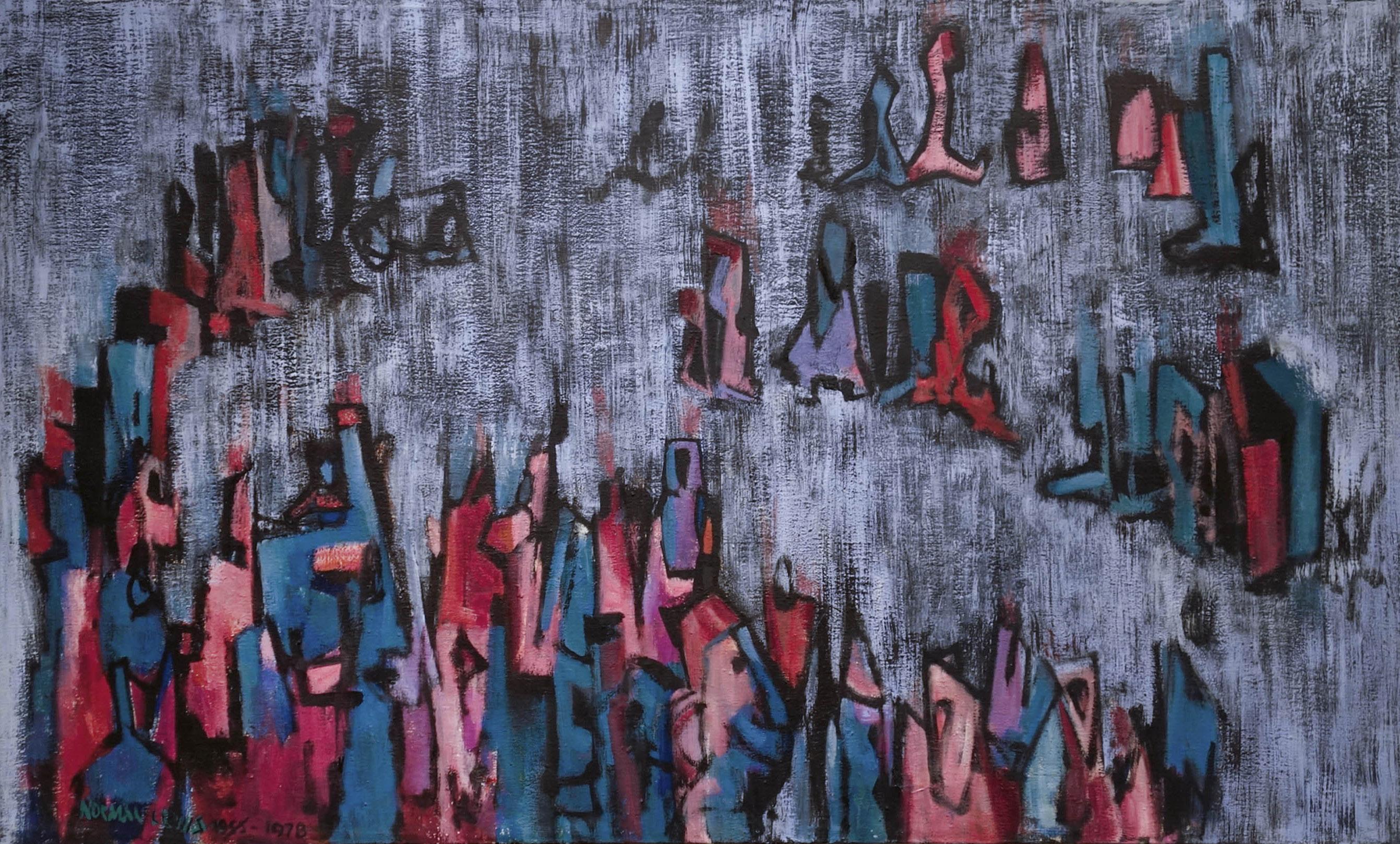
Oil on Canvas
37 1/4 x 62 ½ in. (94.6 x 158.8 cm)
Signed and Dated, Lower Left: NORMAN LEWIS 1955 – 1978
Self-described as an “archaeological ethnographic Dadaist” with the intent to “reveal the life force in inanimate objects,” Willie Cole salvages and repurposes objects, to refashion and reposition our perspective of the ordinary and the mundane.
Willie Cole is a New Jersey-born artist working in the disciplines of painting, drawing, sculpture, and conceptual art. Trained as a graphic designer with a background that includes theatre, music, and television, Cole’s practice is an exploration of postmodern eclecticism and identity, with a focus on African and African American experiences in art.
Under the artistic influence of writer and poet Amiri Baraka, Cole attended the Boston University School of Fine Arts, and received his B.F.A from the School of Visual Arts, New York. Later, he continued his education by attending classes at the Art Students League of New York. During the early 1980s, he formed the nonprofit Works Gallery in Newark. His practice reached a decisive phase in the late 1980s, after receiving the award of artist in residence at the Studio Museum in Harlem (1988-1989).
Cole’s unique works have been included in many solo and group exhibitions, and in museums across the United States. They have been collected by more than 30 museums throughout the country, including Studio Museum in Harlem, NY; Metropolitan Museum of Art, NY; the Whitney Museum of American Art, NY; Museum of Modern Art, NY; and Museum of Contemporary Art, Chicago, IL; among many others.
Are-rendering of a Black lawn jockey statue whose title, Elegba (pp. 25-27), refers to a Yoruba deity and is a fascinating example of the artist’s thematic interest in capturing Africanist and African American canonical symbolism in contemporary art. Black lawn jockey statues were used during the Civil War to provide directional signals to runaway slaves as they journeyed toward the Canadian border. Due to its innocuous appearance that capitalizes on the servile archetype of Sambo figurines, the Black lawn jockey was a subversive tool for the Underground Railroad. Cole uses cowrie shells to adorn the figure’s beaded vestments. Interestingly, cowrie shells symbolize wealth, fertility, and protection when traveling across stormy waters. In this work, Cole masterfully uses medium and symbolism to produce a sculpture that engages with the complex history of the Transatlantic Slave Trade.
Provenance: Alexander and Bonin; New York, NY Private Collection (2007)
Exhibition History:
(Self) Portraits, 2 June - 27 July 2001. Alexander and Bonin, New York, NY Sources & Metamorphoses, 4 February - 4 April 2004. Tampa Museum of Art, Tampa, FL
Literature: Montclair Art Museum. Anxious Objects: Willie Cole’s Favorite Brands. Montclair, 2016. pp. 64-65
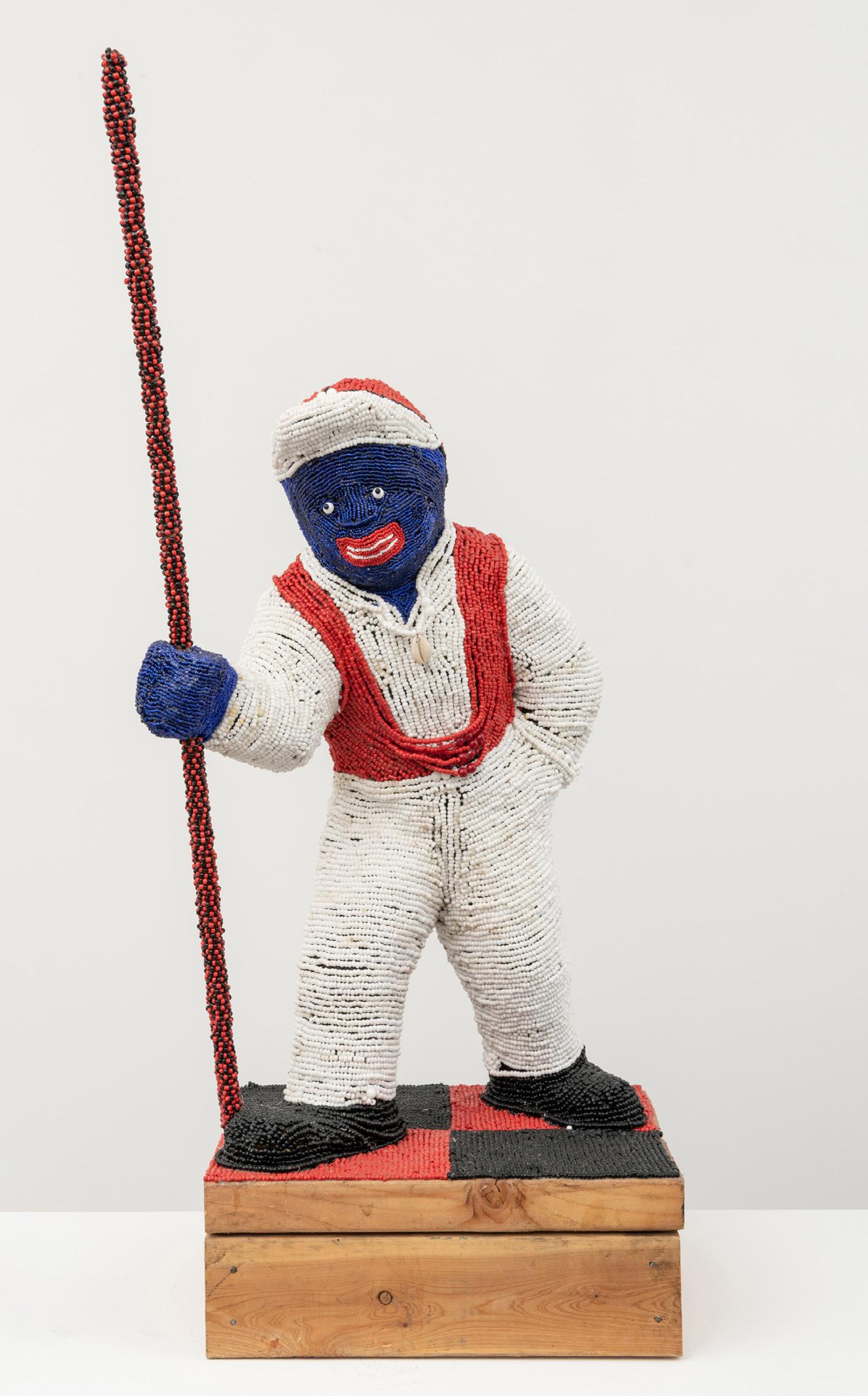
Adam Pendleton, born in Richmond, Virginia in 1984, is an American conceptual artist known best for his screenprints, paintings, collage, and video performances. At the age of 18, he moved to New York City to build a career as an artist. His work often involves an aesthetic intervention on language and color, contextualizing histories through abstracted text and image. Pendleton’s early period consisted of conceptually driven abstract paintings, often incorporating word into form. In 2004, Pendleton received his major solo exhibition, Being Here, at Wallspace Gallery, New York, which coincided with his participation in the group show, When Contemporary Art Speaks, at the Indianapolis Museum of Contemporary Art, Indiana. In 2005, Pendleton had his first solo exhibition at Yvon Lambert, New York, presenting text-based screenprint paintings that encorporated the writings of Toni Morrison and Audre Lorde, among other poets into colorful compositions, overlapping the critical use of language and activism onto conceptual art.
In 2008, Pendleton began to develop his work through the idea of Black Dada, an evolving inquiry into the relationships between Blackness, abstraction, the avant-garde, and their respective histories. “Black Dada is a way to talk about the future while talking about the past,” Pendleton writes. A term with contextual roots in Amiri Baraka’s 1964 poem Black Dada Nihilismus and German poet Hugo Ball’s 1916 Dada Manifesto, Pendelton’s Black Dada figures as the title of a few of his early performances and a series of paintings which followed not long after.
His art has been shown at the Museum of Modern Art, the Whitney Museum of American Art, the New Museum, as well as abroad at La Triennale at the Palais de Tokyo in Paris. Pendleton has twice been featured in Forbes Magazine's 30 Under 30 list. He continues to live, practice, and cutate in New York.
Receiving his first solo exhibition at MoMA in 2022 including his works in paintings, drawings, textile works, sculptures, moving images, and a sound piece, Adam Pendleton showcased his academic importance, tightly connected to Black Dada, which has underpinned his work for more than a decade showing his exploration between theories of Blackness and abstraction/ avant-garde. Afro-Futuristic presents Pendleton’s early studies on the subject of both the history of and the contemporary themes within Black America. Minimalistic with large text stating “AFRO FUTURISTIC” expanding in dark grey bold lettering across a tinted image of what appears to be an imposed photograph of the legs of a person standing adjacent to studio spotlight on one side and a chair resting above a chalky “x” spot mark. Though minimalistic, Adam Pendleton manages to take the viewer back to a day when black exploitation films in America were popular; displaying a time when films with names like “afro futuristic” would have flashed across the T.V screen of many Black American families.
Provenance
Perry Rubenstein Gallery, New York Private Collection
Bill Hodges Gallery, New York, NY
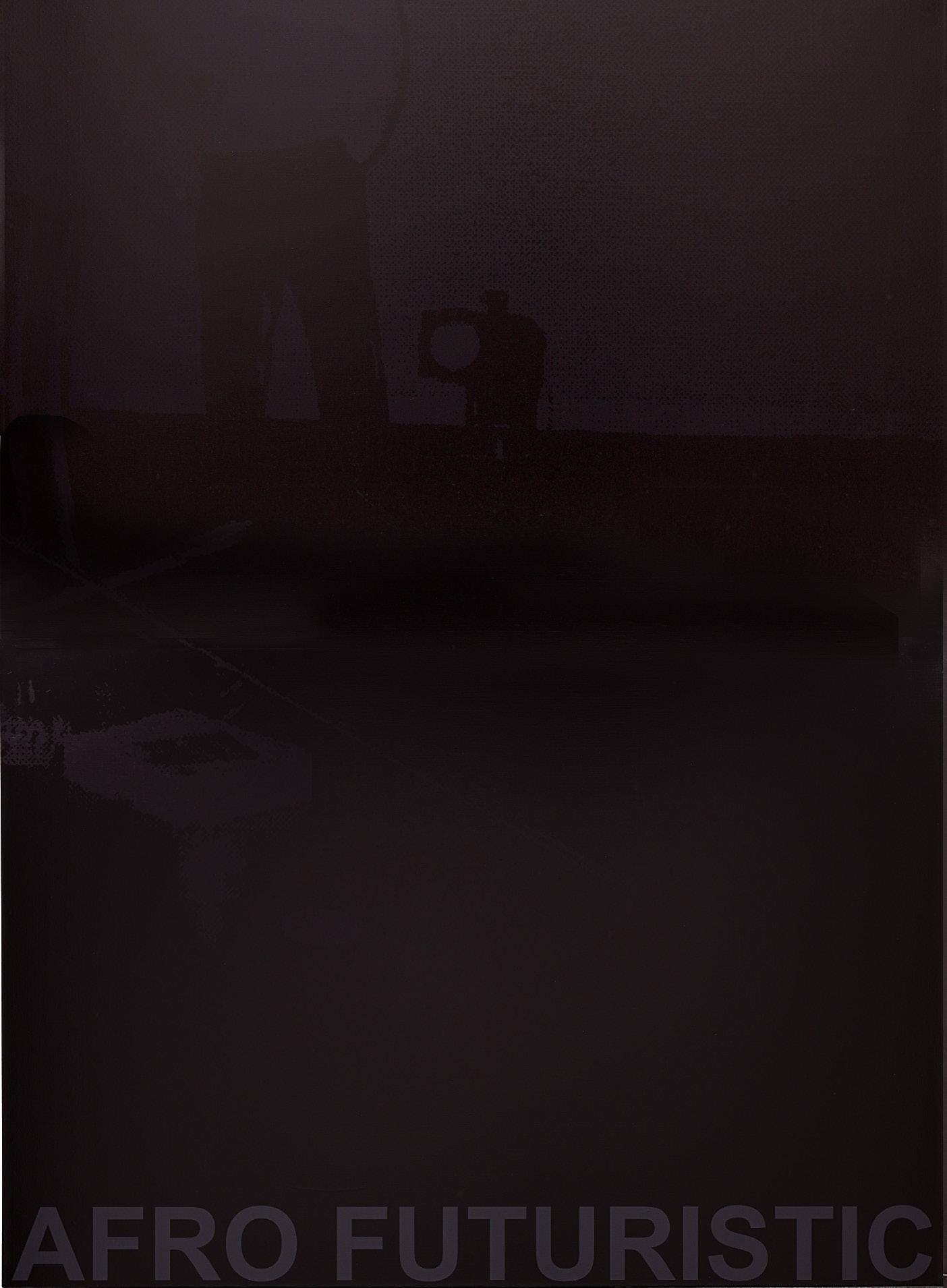
African American multi-talented artist and filmmaker, Camille Billops, worked in a variety of disciplines, but is principally recognized today for her documentary film-making, and contribution as an archivist of African American art and culture. Billops was born on August 12, 1933, in Los Angeles, California. She studied at Los Angeles State College during the 1960s major in Special Education, and later graduated with a B.A. from California State University, followed by an M.F.A. from the City College of New York in 1975.
Billops’ early career focused on sculpture; although she occasionally worked with painting, ceramics, printmaking, and photography. By the 1980s, she established herself as a filmmaker through documentaries. Notably, her own family became the subject of many of her films. Of the most well-known of these films is Suzanne, Suzanne (1982), a film about drug addiction within her own extended family; and Finding Christa (1991), which explores the artist’s reunion with her abandoned daughter. The latter touched on taboo subjects around issues of motherhood, the African American family, and trauma. In 1992, Finding Christa was awarded the Grand Jury Prize for documentaries at the Sundance Film Festival. This film stands as Billops’ most recognized and acclaimed controversial work.
Billops’ legacy extends beyond her artistic practice, to include the role of archivist of African American art and culture. In 1968, she established, with partner James Hatch (a scholar of African American theater), the HatchBillops Collection of African American literature in Manhattan (currently housed at Emory University). Billops’ artwork is in the collections of the Boston Museum of Fine Arts, Boston, MA; Georgia Museum of Art, Athens, GA; Harold A and Ann R Sorgenti of Contemporary African American Art, Pennsylvania Academy of the Fine Arts, Philadelphia, PA; Museum of Fine Art, Boston, MA; Museum of Modern Art, NY; Nasher Museum of Art, Durham, NC; the Petrucci Family, Union Township, NJ; Photographers’ Gallery, London, UK; and Studio Museum in Harlem, New York, NY; among many others.
Billops transfers her colorful, expressive, almost caricaturish paintings of people interacting in a noneuclidean space onto the surface of a large black ceramic bowl of her creation, Title Unknown. This unique painting resembles a reel, with no beginning and no end, no left or right side. Inspired by African art and its aesthetics of color, Billops paints in a playful, almost childlike manner, similar to Matisse and Picasso. With a pastel palette and in her raw and distinct style, Billops paints figures of black and white people interacting in an outdoor context of land and occasional trees, surrounded by a black background, the bowl. Billops illustrates loosely drawn forms with black contours colored in flat washes of paint on its surface. The brushstrokes are visible, and the shapes are arranged like puzzle pieces. Although the foreground and background seem to merge as one flat surface of colored shapes, this image has depth. As evident in her depictions of the small trees and houses, Billops uses scale to create, distance, and depict the vastness of land. The contrast between the background and foreground colors brings light to the images. She creates a boundary between the interior and exterior of the bowl with yellow brush strokes along its inner rim. Thus, producing a dance between light and dark, balancing the composition and its colors.

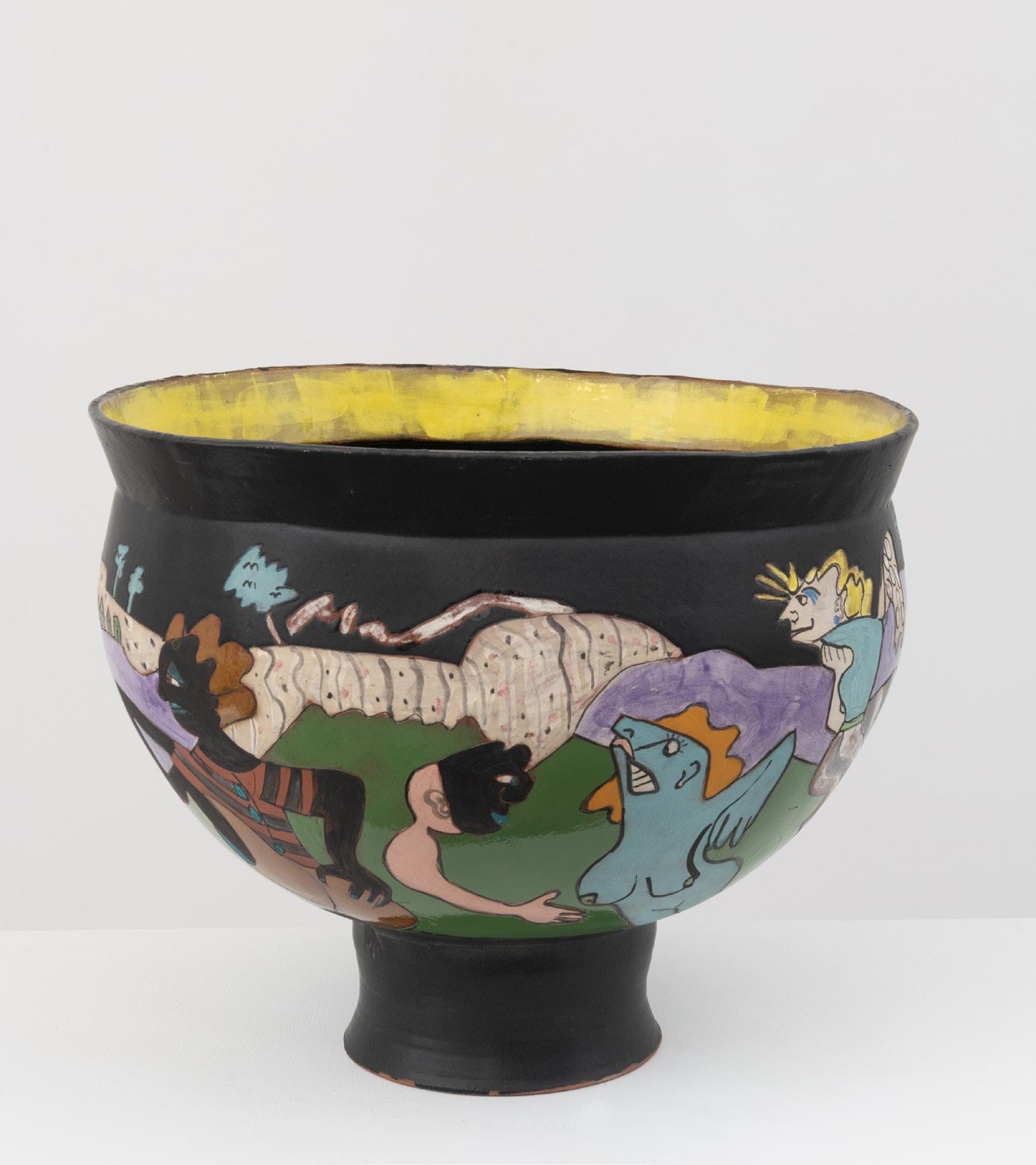
In the 1940s, after the renowned government program Worker’s Progress Administration (WPA) concluded, Norman Lewis taught at the George Washington Carver School in Harlem alongside Elizabeth Catlett and Charles White. During this time, Lewis’ style evolved gradually from figurative towards abstraction, characterized by his stylized use of calligraphic lines and loose representations. With this shift, his works began to receive public recognition: Lewis had his one-person debut in 1949 at Willard Gallery; his works were included in the 1951 MoMA exhibition titled Abstract Painting and Sculpture in America; and he won the Popularity Prize at the 1955 Carnegie International Exhibition. In adition, Lewis remained socially engaged with other artists of his generation. He attended Studio 35 meetings, organized by Mark Rothko, Robert Motherwell, and William Baziotes, alongside Ad Reinhardt, Franz Kline, Willem de Kooning, and Alfred Barr. However, he was not often properly recognized for his contributions as a Black artist due to his abstract style.
Games, painted in 1965 by Norman Lewis, presents a captivating oil artwork that captures a gathering of abstract figures encircling against a backdrop of deep blue. Within this composition, the figures comprise not only individuals but also animals and assorted creatures, and their forms are distilled into geometric elegance. Facial and bodily characteristics are selectively accentuated or omitted, resulting in a unique harmony. Amidst these figures emerges a poised man donning a blue hat and suit, his demeanor serene as he indulges in a contemplative cigarette. Adjacently, a white figure—perhaps a dog—exudes jubilant emotion, its laughter symbolically echoed through its open mouth. A deliberate luminance adorns the painting’s center, ingeniously drawing our gaze toward the heart of the scene, while each figure’s presence casts graceful shadows. Delving into the artwork, the figures’ physical structures evoke a profound kinship with the symbols, letters, and motifs found in African art. Remarkably, African artistic influences stand as a linchpin in Lewis’s creative evolution, gifting him not only cultural insights but also novel perspectives on the essence of artistic expression.
Provenance Private Collection
Bill Hodges Gallery, New York, NY
Exhibition History
Selections from the Hamptons Virtual Art Fair, 3 September – 17 October 2020 Bill Hodges Gallery, New York, NY
Literature
Bill Hodges Gallery, Norman Lewis: A Painter's Odyssey 1935 - 1979, New York, 2009, illus. p. 27 Bill Hodges Gallery, Norman W. Lewis, et al., New York, 2017, illus. p. 25 Bill Hodges Gallery, Masterworks of the African Diaspora, New York, 2023, illus. p. 25
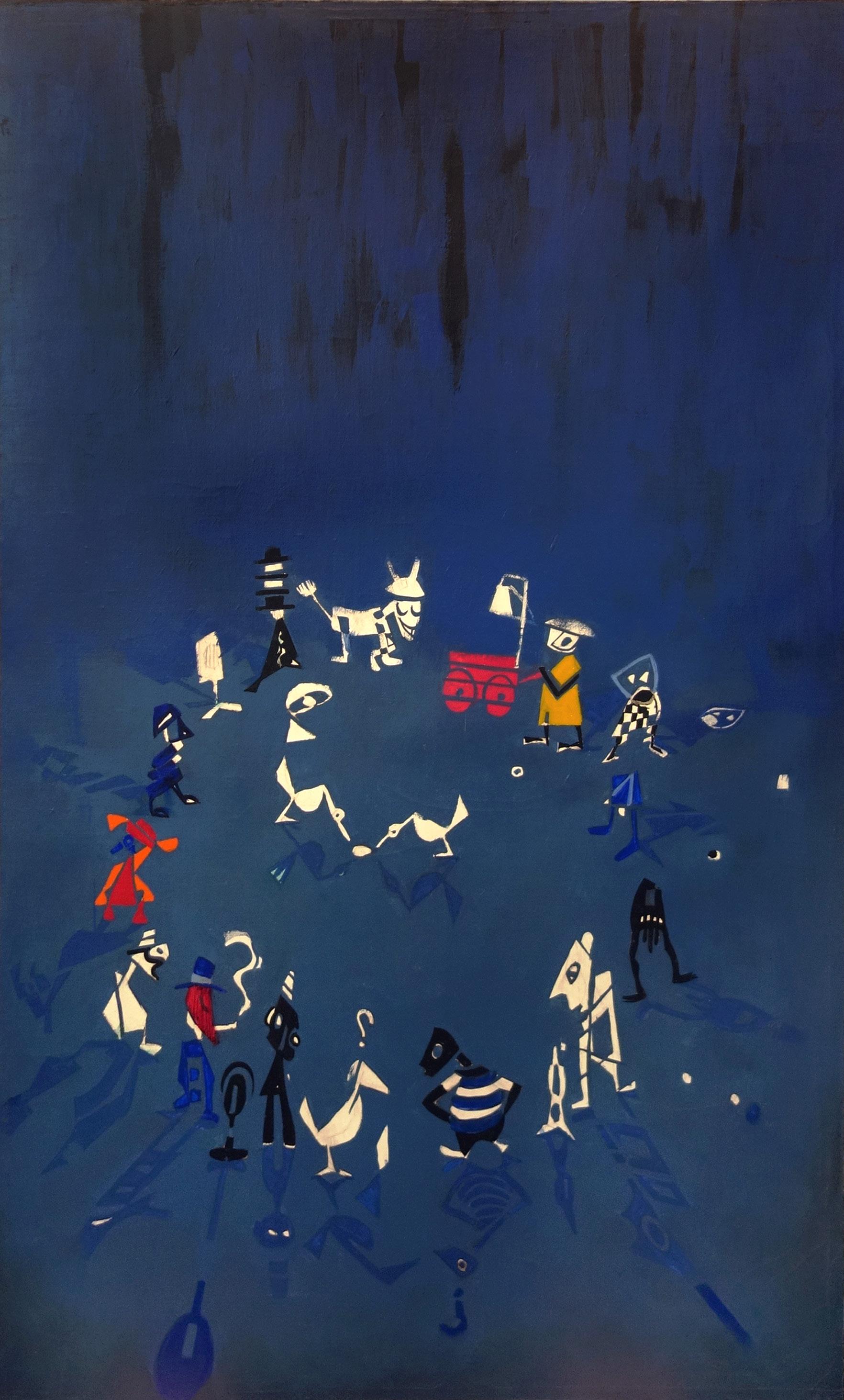
Harold Cousins was born in Washington, D.C. in 1916. He was raised in the neighborhood of U-Street N-W, termed "Washington D.C.'s `Black Broadway.'" As a teen, Cousins was known to have an interest in the arts; he carved a series of sculptures out of soap and designed assemblages from mixed materials. Curious about the great variety of works produced by artists throughout history, Cousins was a frequent visitor of art museums in D.C. The cultural education he found there was a tremendous source of aesthetic inspiration. Cousins attended Howard University in 1943, where, like Elizabeth Catlett, his emerging perspective as an artist was shaped by the influence of his professors. Specifically, Dr. Ralph J. Bunche, who would become the first African-American appointed U.S. ambassador to the United Nations, and Dr. Alain Locke, who conveyed to Harold his deep understanding and appreciation for African art, were particularly instrumental.
After the Second World War began, Cousins joined the Coast Guard and served from 1943 to 1945 as a Sonar man. After the war, he returned to his job with the U.S. Post Office while taking sculpture classes at night. However, finding existential constraint in the institutional prejudice that was commonplace in America, Cousins left the country and expatrioted to Paris. He developed a strong following and took part in numerous artistic ventures, including appearances in U.S. State Department documentary productions and taking on the role of artistic director for Monitor Productions, an international film consortium. He was also a guest speaker at the Sorbonne University of Paris and was featured in widely-read American and international magazines and revues, including Ebony Magazine in 1953. Cousins' body of work continues to inspire reflection on tender form and figuration through metallic relief. With his signature welding style, Cousins built delicate, expressive sculptures, working with metal so fine that it appears almost as a drawing lifted from the page.
Engaging in audacious exploration through metal sculptures, The Winner, crafted in 1974 by Harold Cousins (1916 - 1992), beautifully exemplifies Cousins’ finesse in crafting captivating structures. This diminutive sculpture unveils a puppet suspended and intricately tethered to an overhead cross frame. Within this modest masterpiece, the puppet’s corporeal narrative unfolds with meticulous precision. Its hands and arms are elegantly poised aloft, while the countenance inclines gently upwards towards the suspended cross. Poignantly, the cross holds every hanging piece, each string meticulously assigned to a distinct body segment, orchestrating a harmonious visual symphony.
Various Metals on Granite Base
27.8 x 7.7 x 7.7 in. (70.6 x 19.7 x 19.7 cm)
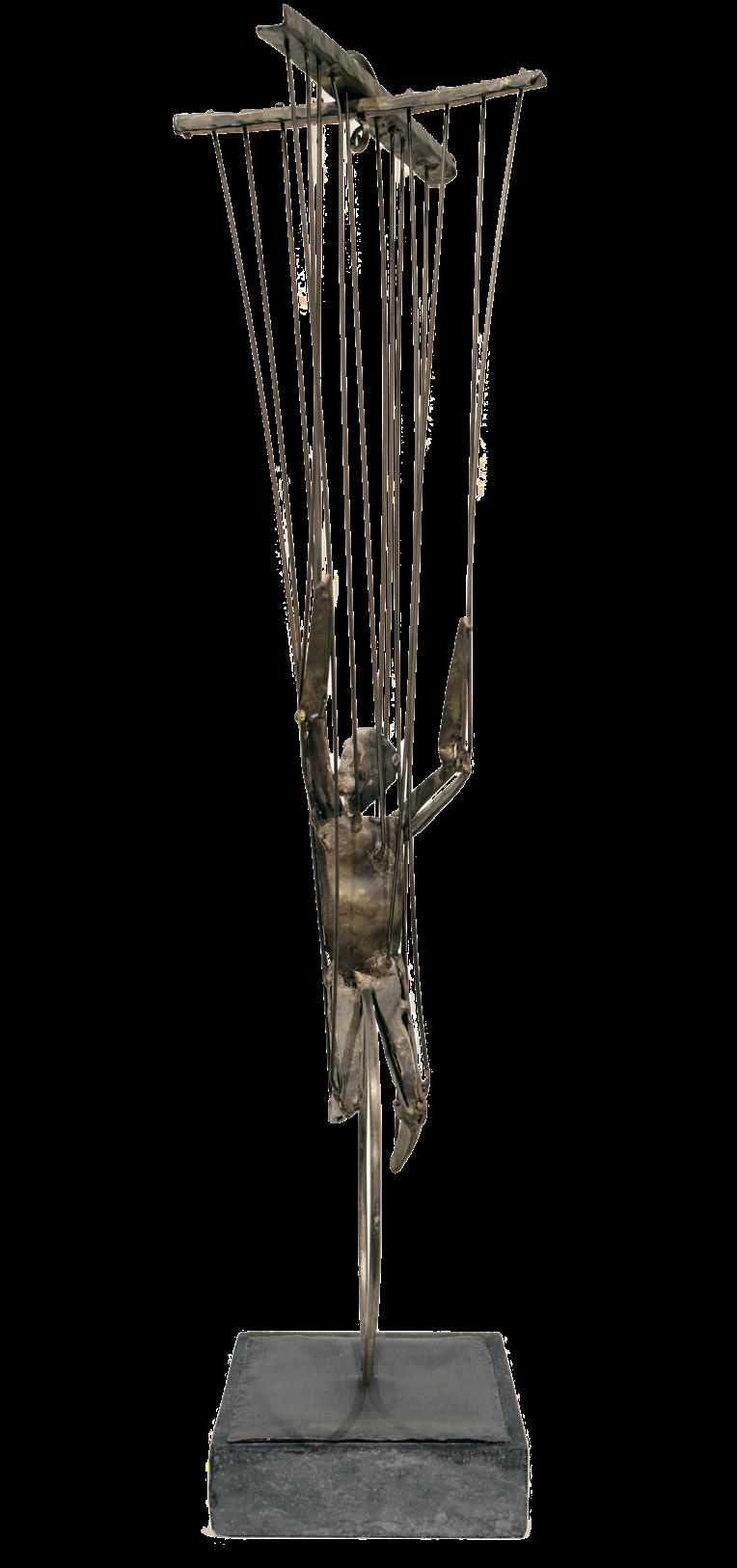
Signed and Dated: H. Cousins, Bxl. 74.


Howardena Pindell is an artist, educator, and curator, leaving influences on the art world as a female African American figure. Trained as a painter, Pindell challenges the tradition of painting using various materials and mediums in composing her works. Using non-traditional materials in her paintings, she allows the paintings to develop out of the flat surface and to fall free and drop without being confined by stretcher support. After arriving in New York after competing for MFA at Yale University, Pindell’s approaches changed drastically. She became more aware of Black Power and feminist movements. She engaged with artists, activists, and feminists and was socially active as a member of the A.I.R. Gallery. In 1979, Pindell experienced a car accident, leaving a short-term amnesia. From this point forward, Pindell’s experimentation moves beyond materiality and engages with different content that constitutes the stories within her art. She uses postcards and photographs, cuts them into pieces, and reconstructed them back into the form of paintings.
Untitled (1998) marks the early periods of Howardena Pindell’s artistic career. While experimenting with various ways of approaching art, Pindell started to lay pieces of paper on the small television and traces the action of each line and dot using arrows and number labels. In this work, the small arrows with number labels near the corner show the particular action of the scene Pindell was tracing through. The repetition of the lines indicates the edges of the scene and its movement between seconds. Untitled shows the amount of physical dedication and the detailed tracing of each movement. It incorporates both the painterly effects through the drawing lines, which became a scene in itself, and leaves spaces for audiences to imagine and guess what the original television screen was showcasing.
Provenance
Collection of James and Brenda Rivers, Atlanta, GA Bill Hodges Gallery, New York, NY
Exhibition History
Masterworks of the African Diaspora, 13 July – 16 July 2023, Hamptons Fine Art Fair, Southamptons, NY
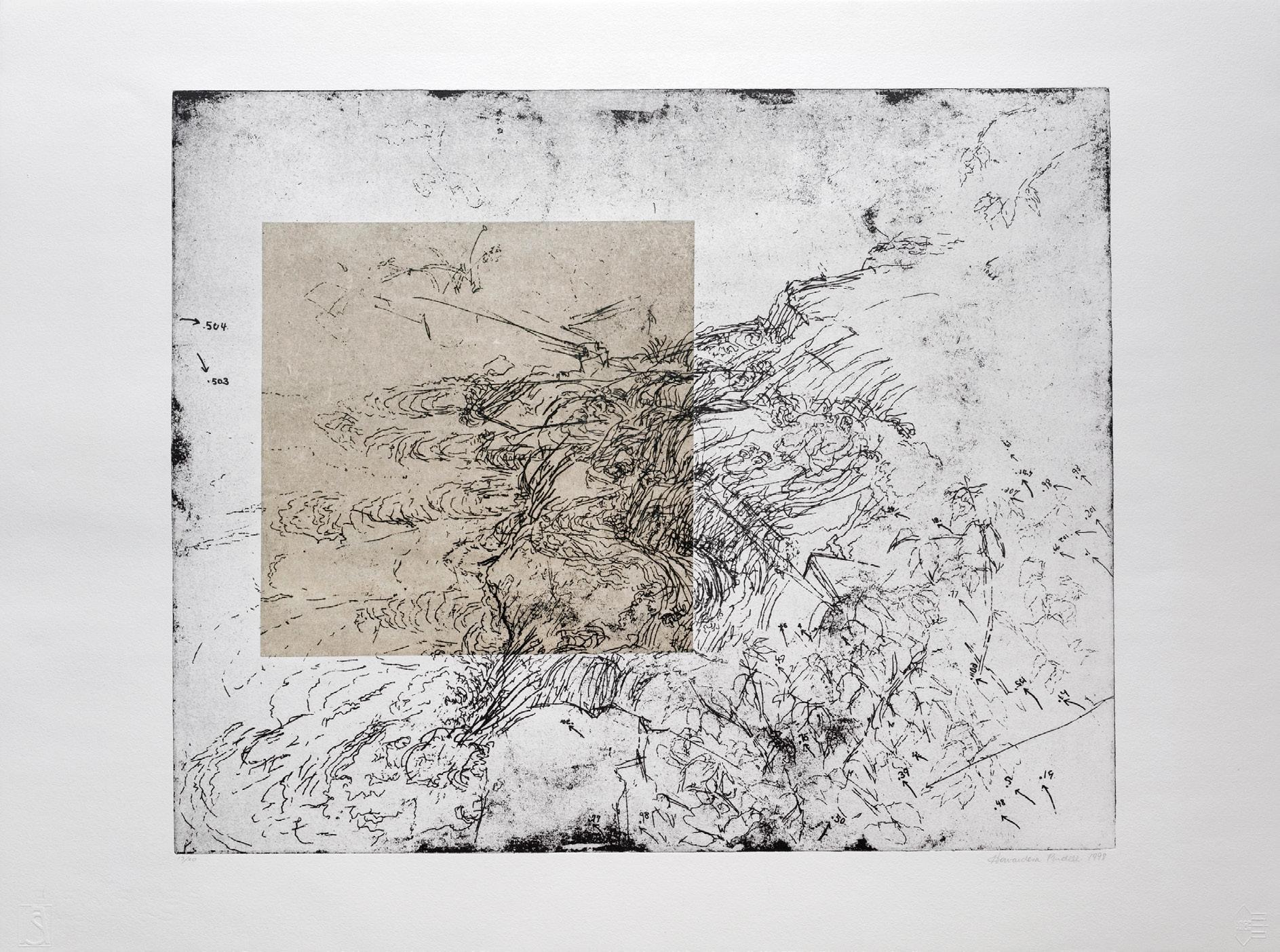
Jo Ann Jones’ narrative paintings and drawings negotiates the intricate space that oftentimes exists between memory and anxiety while addressing the complex nature of relationships; be it our relationship to strangers, best friends, or lovers. Most of the work is on an intimate scale, allowing the viewer to simultaneously investigate and experience the entire painting as a whole from a comfortable distance. Jo Ann studied at the University of Illinois and received her MFA from Yale University. She has received the Joan Mitchell Foundation Painting Award, fellowships at Skowhegan School of Painting and Sculpture, the MacDowell Colony and will take over as chair of the Painting Department at the Maine College of Art in Portland, Maine.
The Conversation, a sculpture in welded metal and wax by Jo Ann Jones is a grey metal color rectangular block with tiny indents on top with wax sculptures inside. There is a total of 12 circular holes on the top surface of the metal block, each perfectly aligns with each other with the same spacing. Inside each space is one pink and brown wax figural sculpture. The shape of the wax sculptures is the same as babies or fetuses with a large head, a tiny body, and short arms and legs. Although each wax figure is placed with different angles facing different directions, all of the wax figures have heads facing top and appear outside the block, and the bodies are sunk into the holes with clear wax fixing them at their places. The entire sculpture sits on top of a brown velvet cushion.
Provenance
Bill Hodges Gallery, New York, NY

Sitting at the edge of a bed with two bare legs holding out from a white blanket or a huge dress or skirt, Today, I’m a man; I wish I were dead, (1995) captures the lower half body of an unidentified figure. The canvas is saturated with colors indicating the environment. The floor is red; the bed frame is olive green; the wall is decorated with green and pink floral patterns; and the mattress is blue. As suggested by the title, the anonymous figure is a female, potentially at a depressing moment in her life. She wears a pair of green flats, while her left shoe is fallen off. The narrative of the painting is incomplete and raises many questions for its viewers. Under the depressing titles, questions over the emotional state of the figure raise strong concerns, especially true when the painting intentionally cuts off facial features. Furthermore, the depiction of the bed scene also creates an ambiguous intimate sphere, with the bold color contrast between the white blanket, which also employs the meaning of purity and cleanness, and the dark red floor and the bright red carpet on the floor. Mysteris remains in the painting.
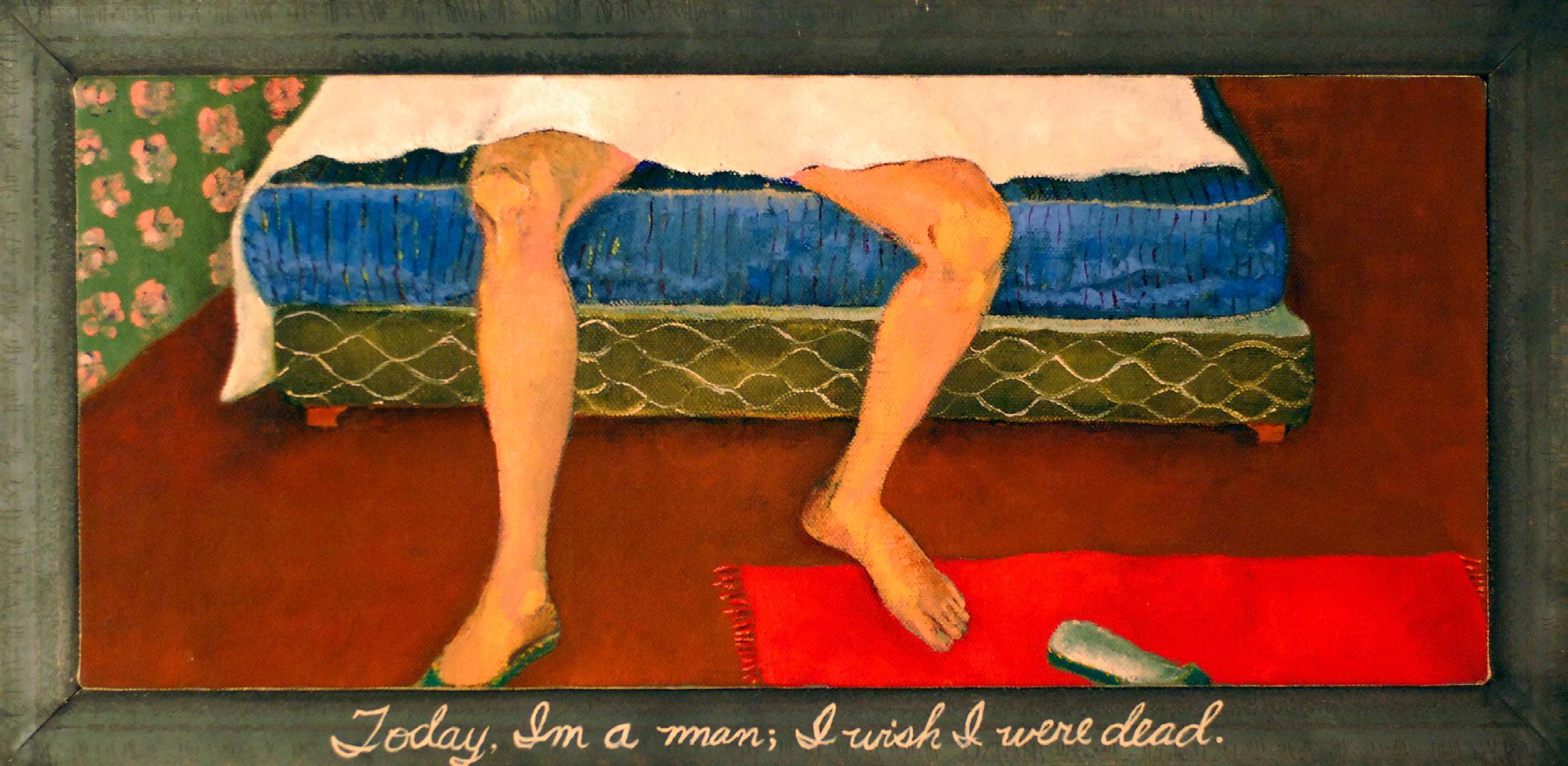
Intrusion by Jo Ann Jones shows the similar metal rectangular block with indents on top. In Intrusion, the smooth and perfect circular spaces on the top surface is deconstructed into organic shaped indents created with forceful breaks. The edges appear rough, the sizes vary, and the spacing of each location is more random without a spatial arrangement but still gathered towards the center. The peaceful distributed of the wax figures are distorted as well. None of the figure has their head facing up, but rather most of them is upside down with their feet above the clear wax facing up. There are two instances where inside one space, there is no clear sign of any wax figure inside and in the other space, there is only a small piece that cannot indicate any particular body parts. The space and situation is transformed from the peaceful to the distorted, however, the figures still exists, posing some extent of hope.
Provenance
Bill Hodges Gallery, New York, NY
Welded Metal and Wax

Untitled (Tall Sink), 1993 depicts an interior scene inside a house. Against a warm tone yellow wall, a tall sink with four skinny and long legs is placed on the left side of the room with a tiny chair with a yellow cushion on top placed on the right. The chair is not in the same proportion as the sink, although it is placed closer to the viewer, it is much smaller as it is reduced. Inside the sink over on the left is a bright orange cup. When looking at the painting in detail its color and paint, the entire painting uses layers of colors. While the sink is grey, pink, yellow, orange, and many other colors are used to depict the reflections on the metal. Similarly, the depiction of the window scene outside the house shows a night scene with black at first view, and with a closer view, green and red appear within the black, potentially pointing to the appearance of a firework.
Bill Hodges Gallery, New York, NY
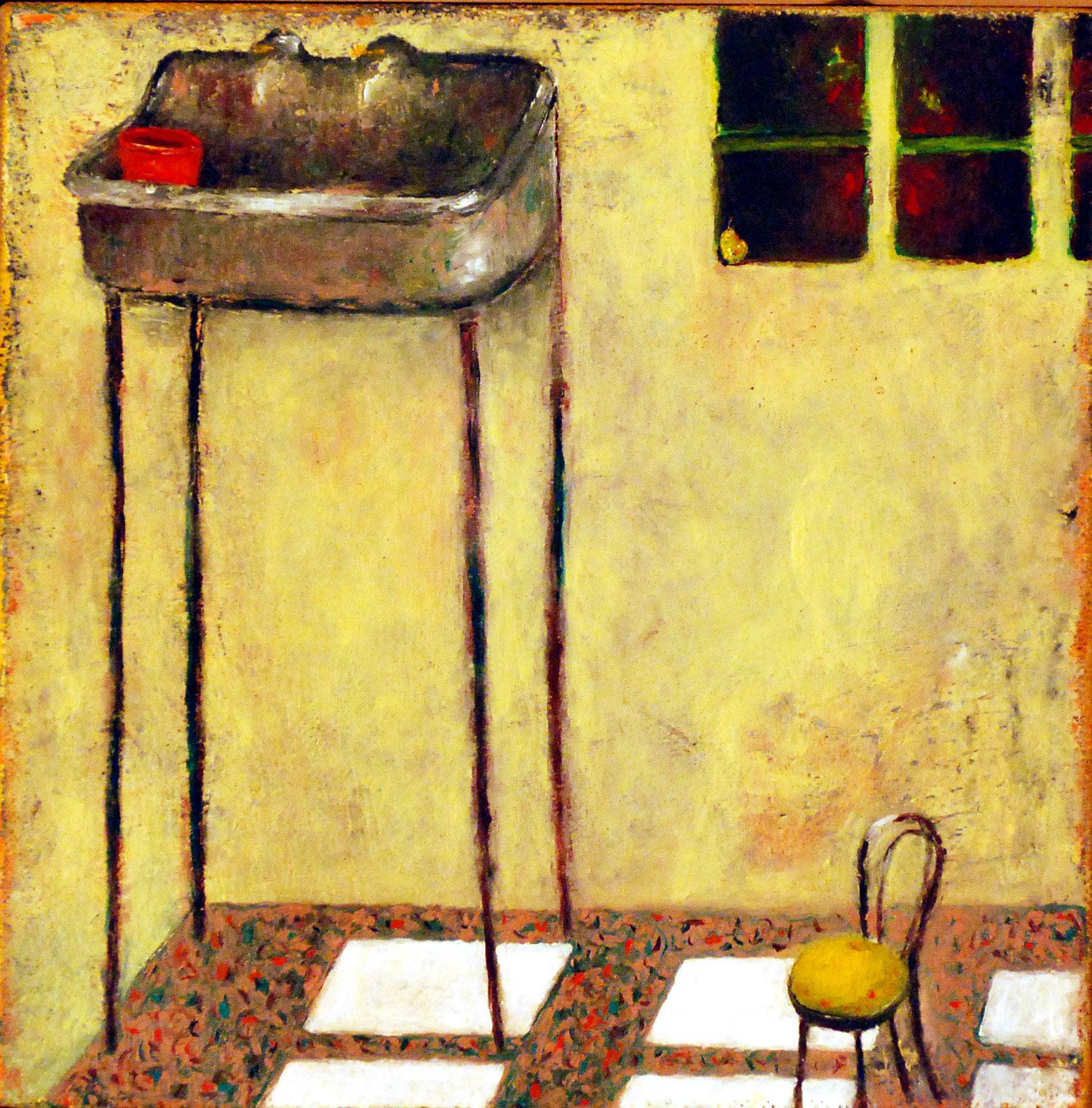
Untitled (Tall Sink), 1993 depicts an interior scene inside a house. Against a warm tone yellow wall, a tall sink with four skinny and long legs is placed on the left side of the room with a tiny chair with a yellow cushion on top placed on the right. The chair is not in the same proportion as the sink, although it is placed closer to the viewer, it is much smaller as it is reduced. Inside the sink over on the left is a bright orange cup. When looking at the painting in detail its color and paint, the entire painting uses layers of colors. While the sink is grey, pink, yellow, orange, and many other colors are used to depict the reflections on the metal. Similarly, the depiction of the window scene outside the house shows a night scene with black at first view, and with a closer view, green and red appear within the black, potentially pointing to the appearance of a firework.
Bill Hodges Gallery, New York, NY
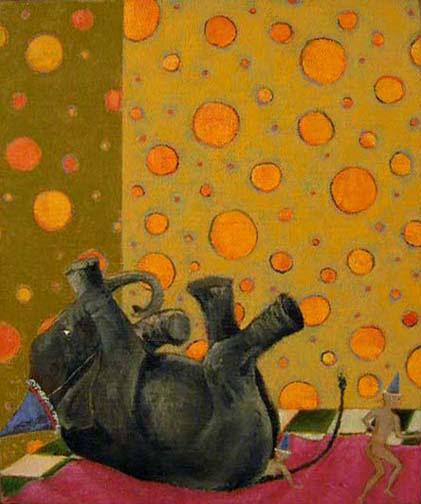
Untitled (Tall Sink), 1993 depicts an interior scene inside a house. Against a warm tone yellow wall, a tall sink with four skinny and long legs is placed on the left side of the room with a tiny chair with a yellow cushion on top placed on the right. The chair is not in the same proportion as the sink, although it is placed closer to the viewer, it is much smaller as it is reduced. Inside the sink over on the left is a bright orange cup. When looking at the painting in detail its color and paint, the entire painting uses layers of colors. While the sink is grey, pink, yellow, orange, and many other colors are used to depict the reflections on the metal. Similarly, the depiction of the window scene outside the house shows a night scene with black at first view, and with a closer view, green and red appear within the black, potentially pointing to the appearance of a firework.
Bill Hodges Gallery, New York, NY
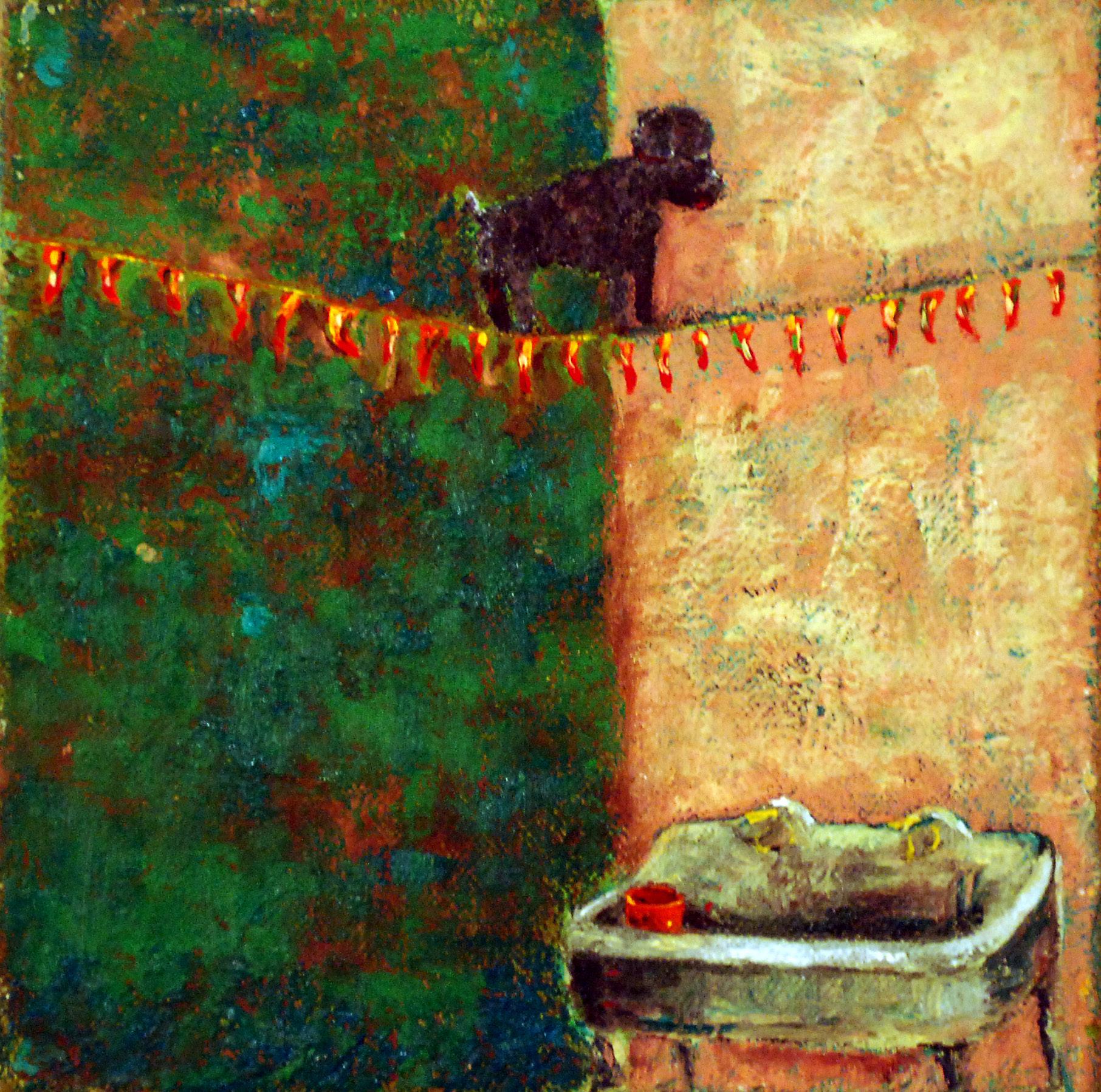
Untitled (Tall Sink), 1993 depicts an interior scene inside a house. Against a warm tone yellow wall, a tall sink with four skinny and long legs is placed on the left side of the room with a tiny chair with a yellow cushion on top placed on the right. The chair is not in the same proportion as the sink, although it is placed closer to the viewer, it is much smaller as it is reduced. Inside the sink over on the left is a bright orange cup. When looking at the painting in detail its color and paint, the entire painting uses layers of colors. While the sink is grey, pink, yellow, orange, and many other colors are used to depict the reflections on the metal. Similarly, the depiction of the window scene outside the house shows a night scene with black at first view, and with a closer view, green and red appear within the black, potentially pointing to the appearance of a firework.
Bill Hodges Gallery, New York, NY
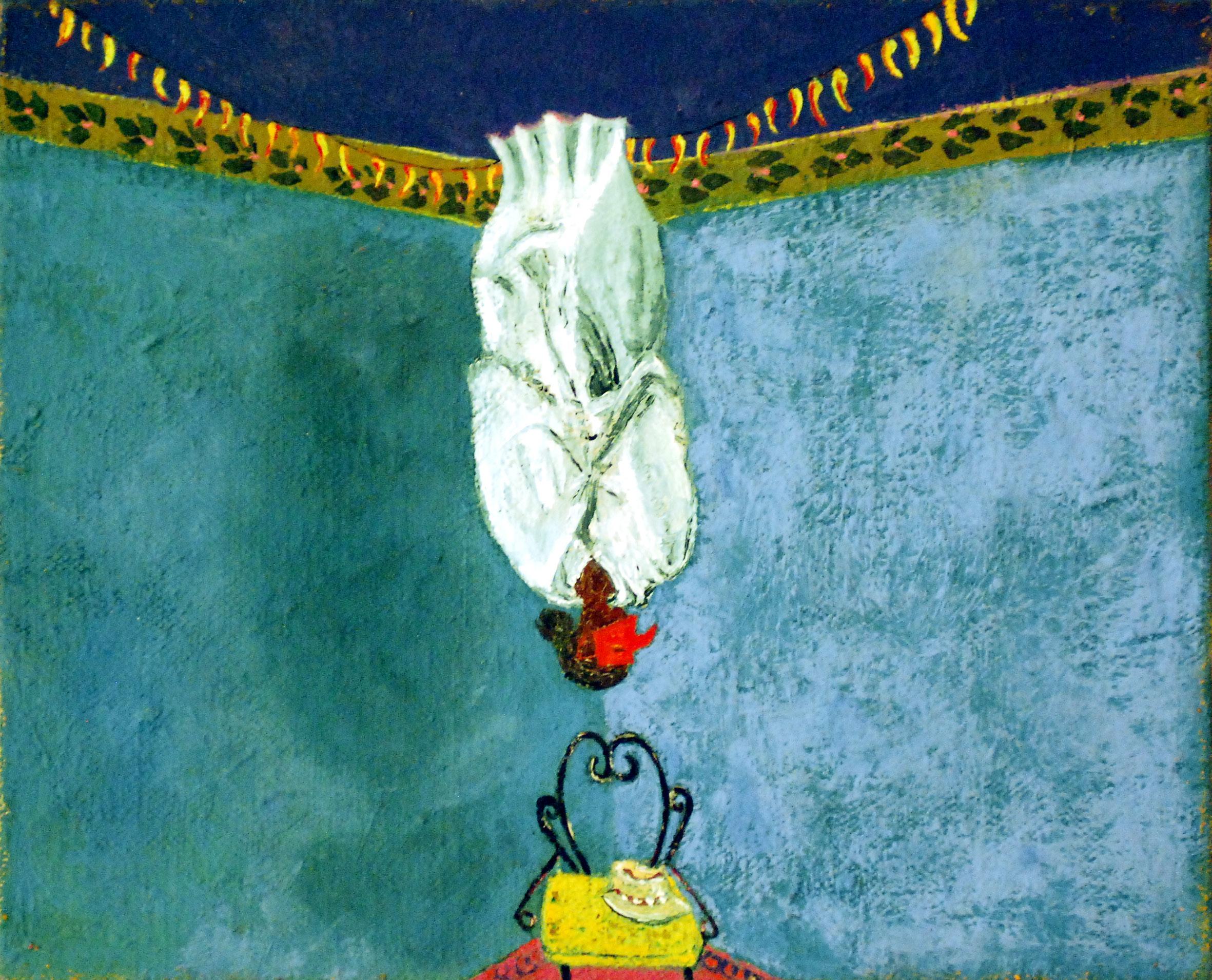
Untitled (Tall Sink), 1993 depicts an interior scene inside a house. Against a warm tone yellow wall, a tall sink with four skinny and long legs is placed on the left side of the room with a tiny chair with a yellow cushion on top placed on the right. The chair is not in the same proportion as the sink, although it is placed closer to the viewer, it is much smaller as it is reduced. Inside the sink over on the left is a bright orange cup. When looking at the painting in detail its color and paint, the entire painting uses layers of colors. While the sink is grey, pink, yellow, orange, and many other colors are used to depict the reflections on the metal. Similarly, the depiction of the window scene outside the house shows a night scene with black at first view, and with a closer view, green and red appear within the black, potentially pointing to the appearance of a firework.
Bill Hodges Gallery, New York, NY
